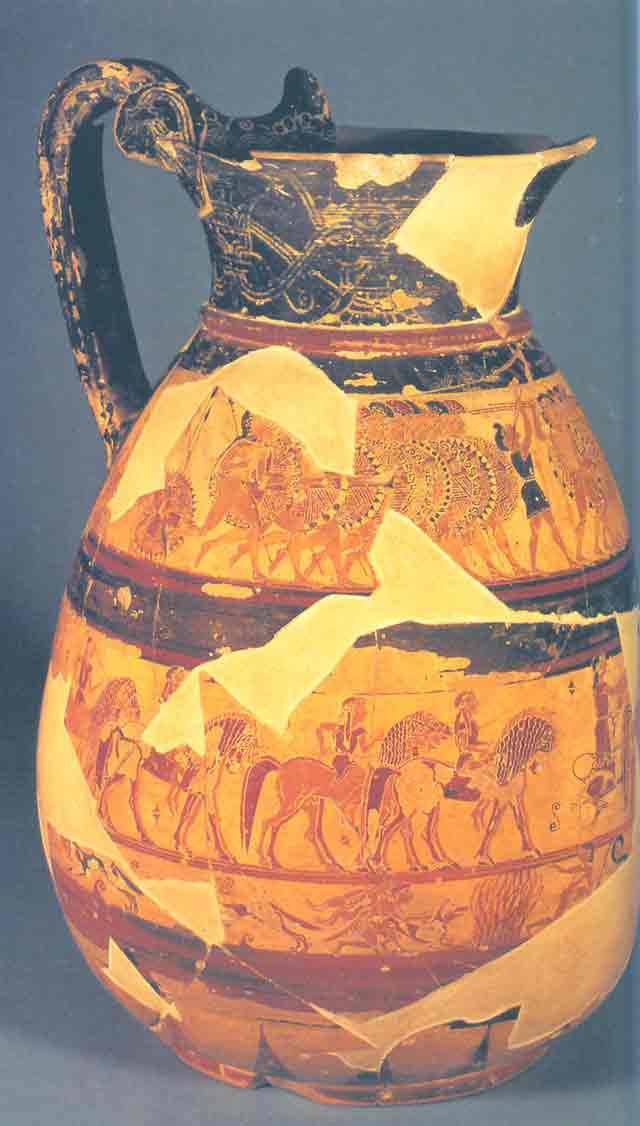
Image: |
|
Name @ Provenance:
The Chigi Vase (protocorinthian olpe), Corinth
Findspot @ Date: Tuscany, 650 BCE
Material @ Size:
10.25 in
Preservation:
Some parts lost
Present Location:
Villa Giulia
Museum, Rome
Description:
Polychrome painting that has three registers of figures; the lowest shows
humans, hounds and hares. Above, there is a procession of chariot, horsemen,
and a lion hunt, which is separated from the mythological scene of Paris’ judgment with
sphinxes. Main frieze shows lines of heavily armed foot soldiers carrying
shields.
Interpretation:
Gives us important information about military history, shows ascendancy of
drilled foot soldiers over cavalry. Very best of protocorinthian vase painting… |
| |
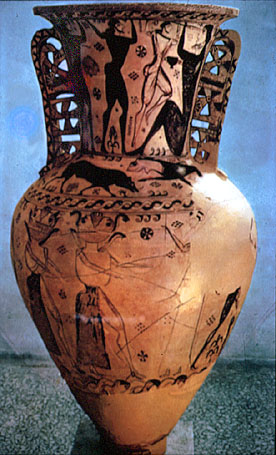
Image: |
|
Name @ Provenance: The
Eleusis amphora
(protoattic amphora)
Findspot @ Date:
650 BCE
Material @ Size:
4ft. 9in.
Preservation:
Perseus and Athena are fragmentary
Present Location: Archaeological
Museum, Eleusis
Description:
Shows the Gorgons in pursuit of Perseus in the main frieze. The hero has just
decapitated heir sister Medusa and is running off with her head. Gorgons drawn
in outline, added white paint shows facial details. On shoulder, animal combat
with boar and lion, on the neck Odysseus and companions blind Polyphemos.
Incision and white paint used for details, image encompasses a wide time span.
Interpretation:
Increasing interest in mythology, conveys victory of Greek hero over world of
monsters. Shows two approaches to narrative: on the body, the single episode of
Perseus to stand for the entire story, on the neck two different episodes
(Polyphemos with wine cup and with eye poked out)… burial jar for a child.
Suggests pre-existing style for drawing narratives. |
| |
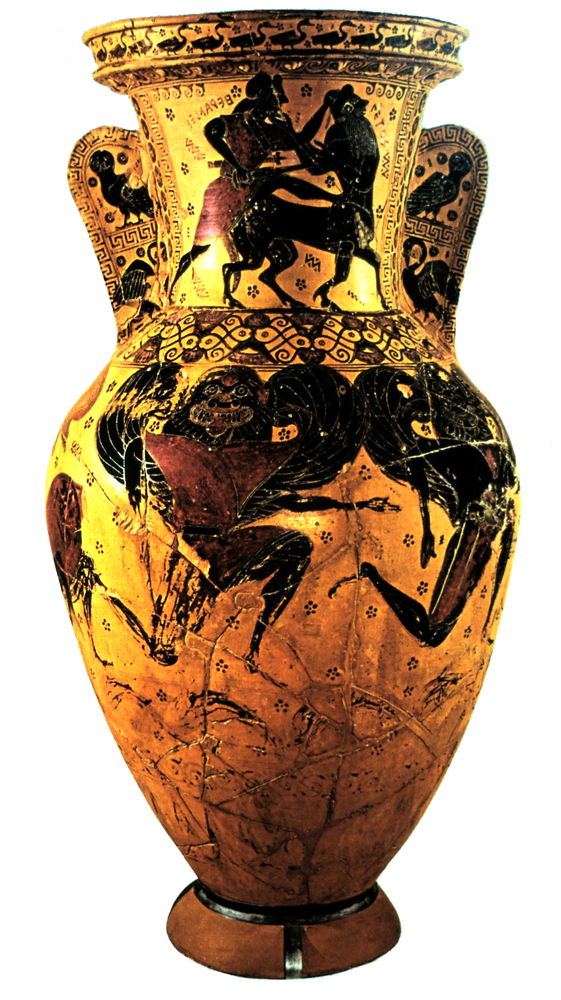
Image: |
|
Name @ Provenance: The Nessos amphora
(late protoattic/early black figure amphora)
Findspot @ Date: Athens, 625-600BCE
Material @ Size: 4ft
Present Location:
National Museum,
Athens
Description:
Non-functional handles, winged Gorgons, tongues protruding, in kneeling
position (meant to show motion). Perseus not shown, but dolphins below
emphasize chase across the ocean. Geese plod around the rim, birds (Athenian
owl) on handles. On the neck, battle between Herakles and centaur Nessos
(identified by inscriptions). Herakles stabs the centaur for violating his
wife, centaur in position of submission.
Interpretation:
At this time, black figure technique introduced and used for large scale
narrative scenes. Geometric fillers no longer used. Transition between
Protoattic tradition and beginning of Attic black figure. |
| |
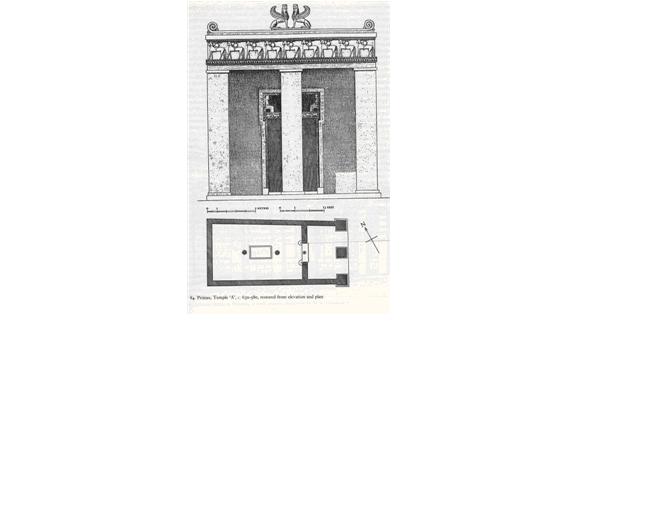
Image |
|
Name @ Provenance:
Plan of temple, Prinias
Findspot @ Date: Crete, 625-600 BCE
Material @ Size: Stone
Description: Rectangular
cella, porch with three enormous piers, one exactly on the axis of the
building. In the interior of the cella there was a hearth or sacrificial pit
flanked by two columns (like Bronze Age Mycenaean halls).
Interpretation: Recalls Bronze Age practices like those at Phaistos. |
| |
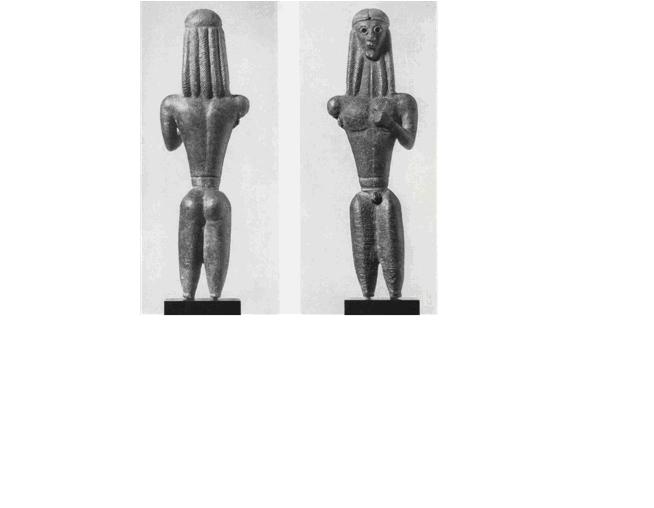
Image |
|
Name @ Provenance: The
Mantiklos Bronze, from Thebes, Boeotia
Findspot @ Date:
700 -625BCE
Material @ Size:
Bronze, 7.8in
Present Location: Museum of Fine Arts,
Boston
Description: Cylindrical
thighs, triangular torso, pyramidal neck, triangular face, and hemispherical
crown. Less two dimensional, more rounded than predecessors. Two hexameter
verses by Mantiklos inscribed on the thighs: “Mantiklos dedicated me to the
Far-shooter with the Silver Bow from his tithe; grant, Apollo, something good
in return”
Interpretation: Newfound
love of writing, prayer to the god Apollo. Familiarity (me) used to suggest
living or lifelike quality of the bronze.
A continuation of geometric forms to show anatomy from pre-Archaic
period.. |
| |
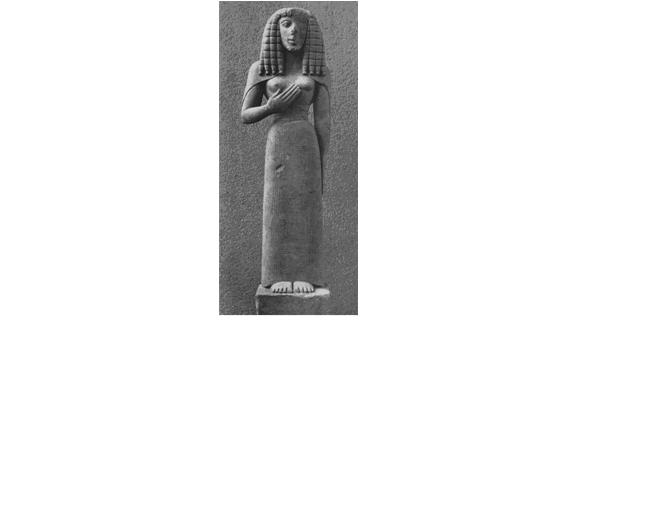
Image |
|
Name @ Provenance: “Lady
of Auxerre” statuette, from Crete
Findspot @ Date: 640
BCE
Material @ Size:
Limestone, 25.5in
Present Location: Musee
de Louvre, Paris
Description:
enlarged translation of the mold-made terracotta form into stone, Daedalic
style after the sculptor Daedalus. Long dress, elaborately decorated skirt with
incised concentric squares that were originally painted, broad belt pinches in
the high narrow waist, cloak covers shoulders. Her face is triangular, low
brow, vertical strands of hair w/ horizontal waves, large feet come out from
skirt. Holds left hand flat agains leg and right hand across body between
breasts
Interpretation: Gesture
signifies adoration,
|
| |
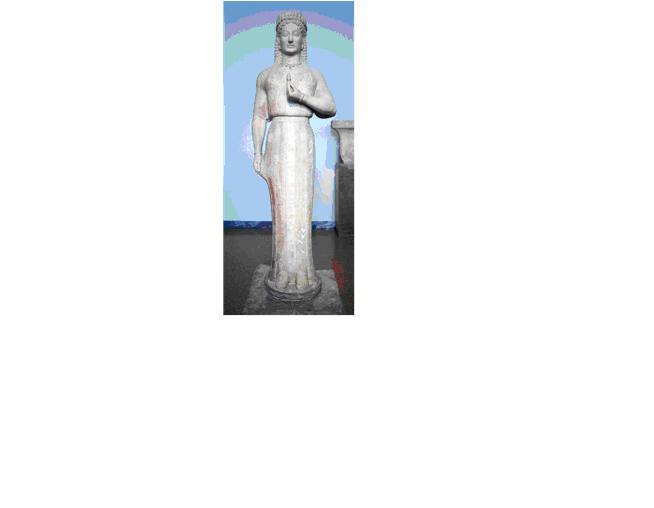
Image |
|
Name @ Provenance: Phrasikleia,
and her inscribed base, from Merenda, Attica
Findspot @ Date: 540
BCE
Material @ Size:
Marble, 6ft 1in
Present Location:
National Museum,
Athens
Description:
Interpretation: |
| |
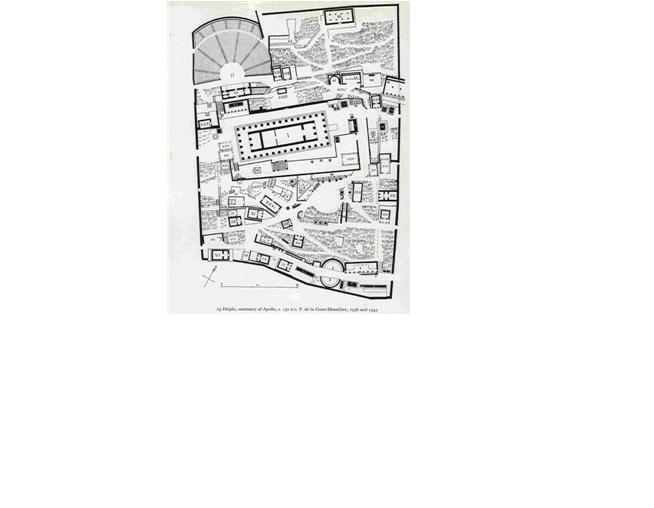
Image |
|
Name @ Provenance: Plan
of the sanctuary of Apollo, Delphi |
| |
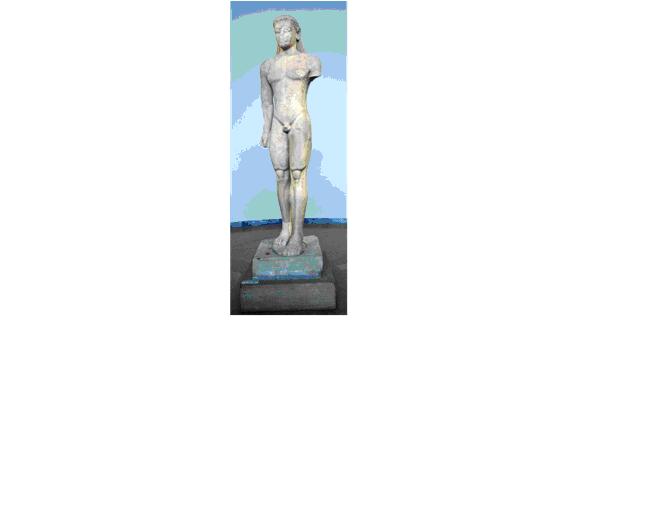
Image |
|
Name @ Provenance:
Sunion Kouros, from Sunion
Findspot @ Date: Sanctuary
of Poseidon at Cape
Sunion, c. 580BC.
Material @ Size:
Marble, 9ft. 10in
Preservation: Left
arm, left leg, and part of face restored
Present Location:
National Museum,
Athens
Description: Massive
head larger than natural proportions, huge eyes, ears, knees, and ribs fixed in
the surface as a pattern on the marble, defined by line rather than mass.
Interpretation: Kouroi
stood in sanctuaries or cemeteries or occasionally represented divinities.
Votive offerings to god or commemorative markers over grave they spoke to the
social standing of the family. One leg always advanced and fists are clenched
at the sides. |
| |
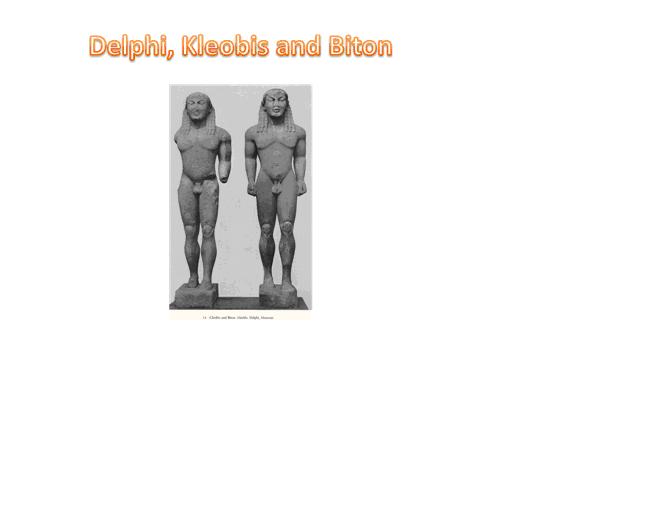
Image: |
|
Name @ Provenance: Twin
kouroi, from Delphi
Findspot @ Date:
Sanctuary of Apollo at Delphi, c. 530BC.
Material @ Size:
Marble, 6ft. 6in
Present Location:
Delphi Museum
Description: Step
forward together. Traveler’s boots on their feet reference the myth.
Inscriptions on base and thighs, and hairstyles reminiscent of Daedalic style,
short, square torsos and stocky proportions.
Interpretation: Associated
with a regional Argive workshop, by “…medes”. Identified as Kleobis and Biton,
who in one of Herodoto’s tales took the place of the missing oxen who should
have pulled their mother’s cart but some scholars argue that they are Castor
and Pollux. |
| |
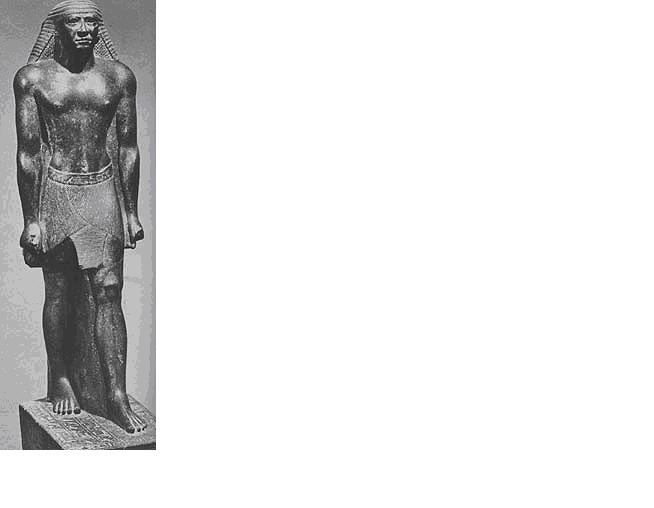
Image: |
|
Name @ Provenance:
Mentuemhet, Egyptian prince
Findspot @ Date:
Early 6th century
Material @ Size:
Granite, 5ft. 6in.
Present Location: Cairo Museum
Description:
Clothed kouroi influenced Greek sculptors who had started making naked
sculptures.
Interpretation: Kouroi
stood in sanctuaries or cemeteries or occasionally represented divinities.
Votive offerings to god or commemorative markers over grave they spoke to the
social standing of the family. One leg always advanced and fists are clenched
at the sides. |
| |
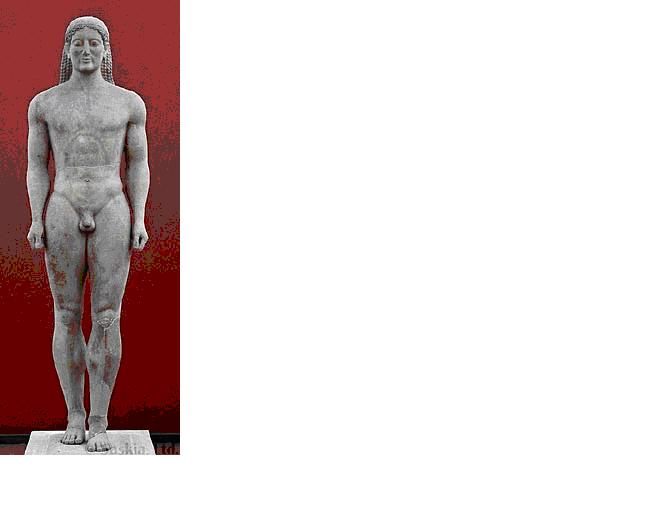
Image: |
|
Name @ Provenance:
Anavysos Kouros, from Anavysos, Attica
Findspot @ Date:
c. 530BC.
Material @ Size: Marble,
6ft. 4.5in.
Present Location:
National Museum,
Athens
Description:
Advances towards more naturalistic proportions and supple contours. The sculptor
has penetrated the block of a greater depth and has achieved better three dimensionality.
“Archaic smile”. Posture, gesture, bilateral symmetry, patterned anatomy, and
hair have not have not changed.
Interpretation: Kouroi
stood in sanctuaries or cemeteries or occasionally represented divinities.
Votive offerings to god or commemorative markers over grave they spoke to the
social standing of the family. One leg always advanced and fists are clenched
at the sides. |
| |
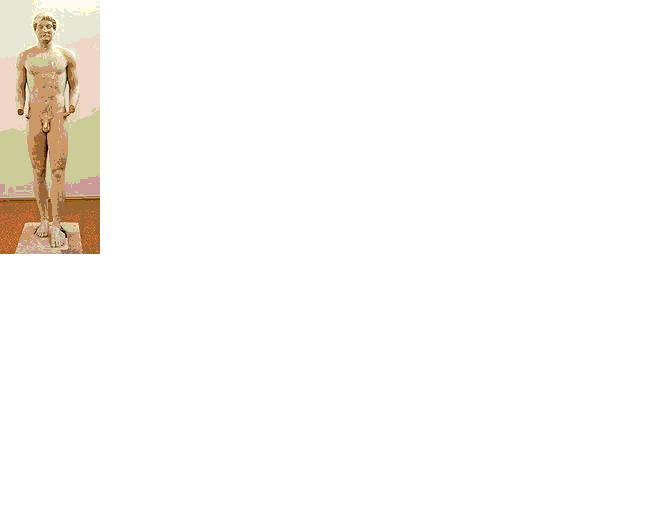
Image: |
|
Name @ Provenance:
Aristodikos Kouros, from Attica
Findspot @ Date:
c. 500BC
Material @ Size:
Marble, 6ft. 5in.
Present Location: National Museum,
Athens
Description: More
naturalistic, shorter but still patterned hair, arms move away from flanks,
sinew, bone, knee, and shin appear more realistic..
Interpretation: Grave
marker of Aristodikos; trying to find more compelling and worth images to
represent both men and gods leads them away from superhuman scale and abstract
linear form. |
| |
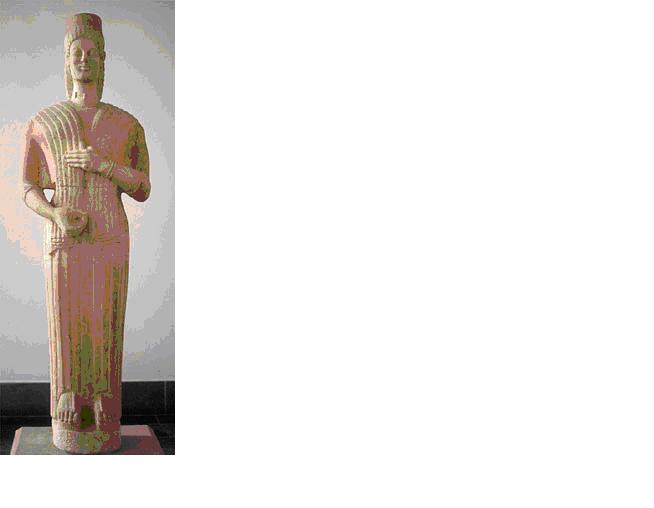
Image |
|
Name @ Provenance:
Berlin Kore, from Keratea, Attica
Findspot @ Date: c.
570 – 560BC.
Material @ Size:
Marble, 6ft. 3in
Present Location: Staatliche Museen, Berlin
Description:
Frontal stance, large features of her face, big feet and hands, holds a
pomegranate, simple lines of her garments, elaborate jewelry – a bracelet, a
necklace, and earrings. Tasseled mantle slung symmetrically over shoulders, a
chiton, and painted headdress.
Interpretation:
Perhaps this funerary statue is a reward for the dead, for compensation or
exchange. Perhaps it is a symbol of family prestige. |
| |
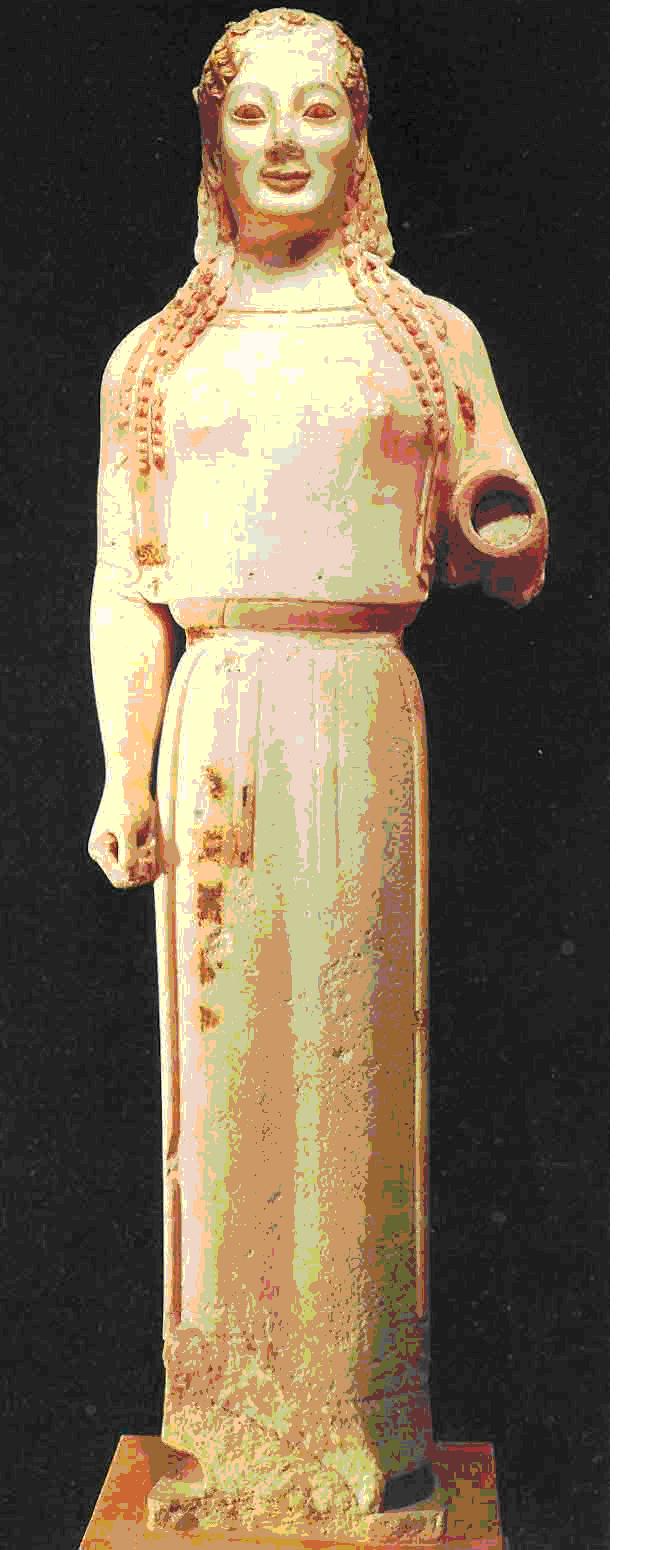
Image |
|
Name @ Provenance: Peplos
Kore, from Athens
Findspot @ Date:
c. 530BC
Material @ Size:
Marble, 4ft.
Present Location:
Acropolis Museum,
Athens
Description:
Wears a peplos over her chiton, among the last of the kore to wear a peplos.
Smaller than life-size, richly decorated with paint, asymmetrical – head turned
slightly, left arm bent carrying the gift. Right arm has hole for a lost meal
attachment
Interpretation: Perhaps
this funerary statue is a reward for the dead, for compensation or exchange.
Perhaps it is a symbol of family prestige. Note the brightly painted/ metal
accessorized statues were much livelier than they are now. |
| |
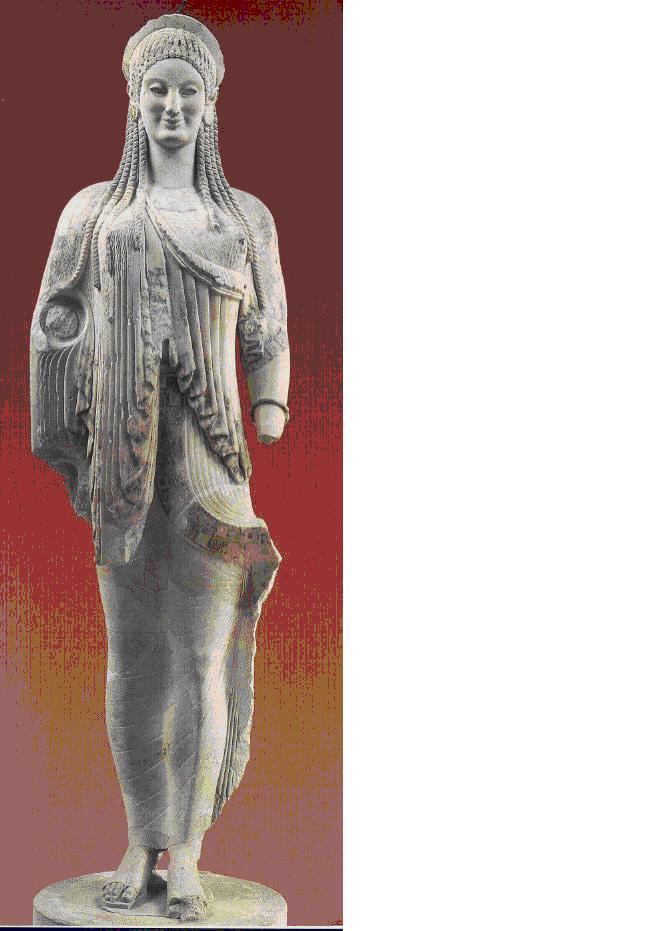
Image |
|
Name @ Provenance: Kore
No. 682, from Athens
Findspot @ Date:
c. 520BC.
Material @ Size:
Marble, 5ft. 11.5in
Present Location: Acropolis Museum,
Athens
Description: Uses
one hand to pull the drapery against her body revealing her form. Example of
the change in fashion of the Kore
Interpretation:
Change in fashion of the Korai: more extravagant hairdos, now they wore a cross
slung himation over crinkly chiffon – brilliance of drapery allows anatomical
form to appear more forcefully |
| |
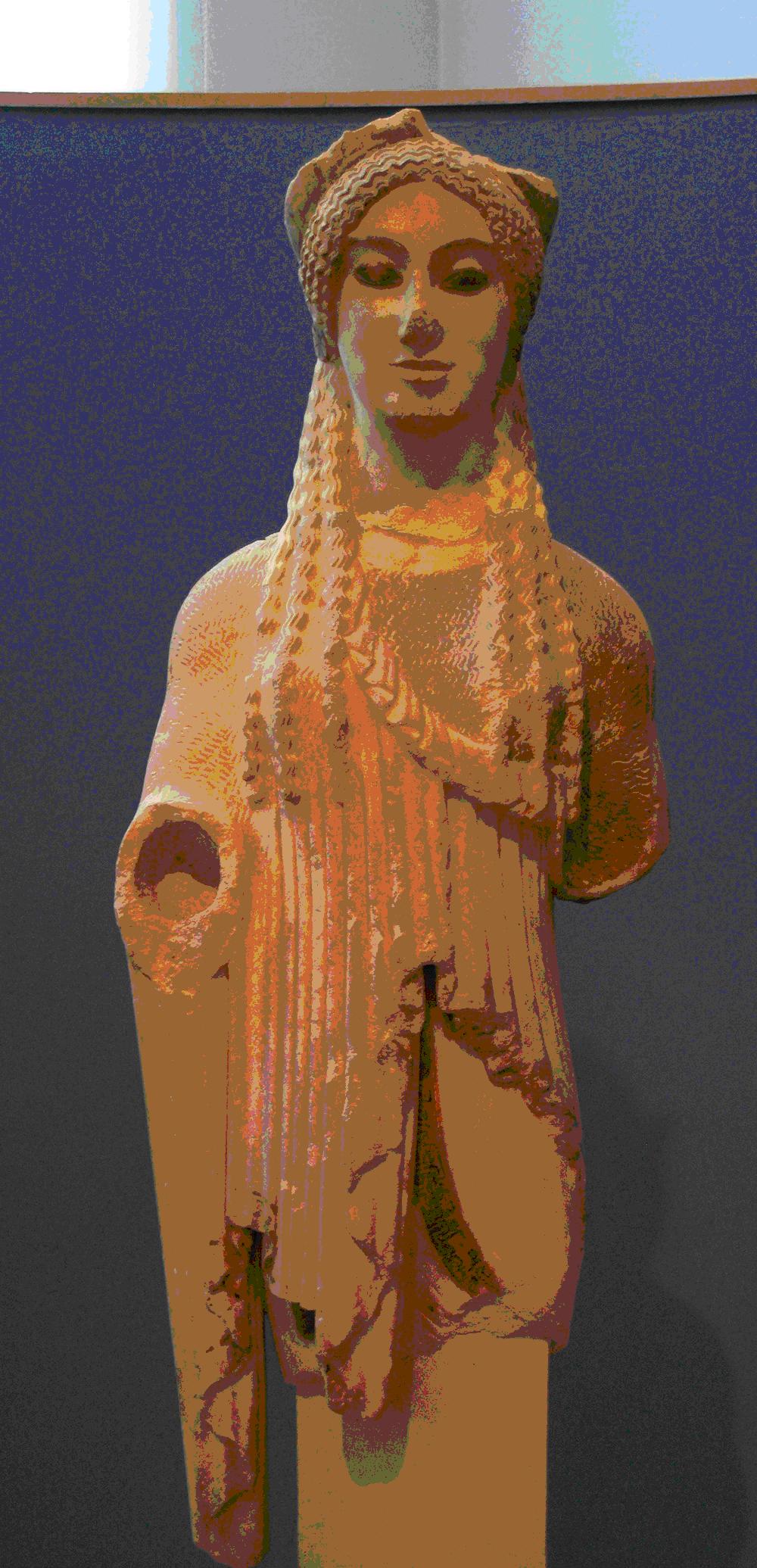
Image |
|
Name @ Provenance:
Kore, No. 674, from Athens
Findspot @ Date:
c. 500BC.
Material @ Size:
Marble, 3ft
Present Location:
Acropolis Museum,
Athens
Description: Complex
patterns of coiffure, grouped folds of the chiton, weightier textured himation
folds, somber facial expression.
Interpretation: New
mood is discernible |
| |
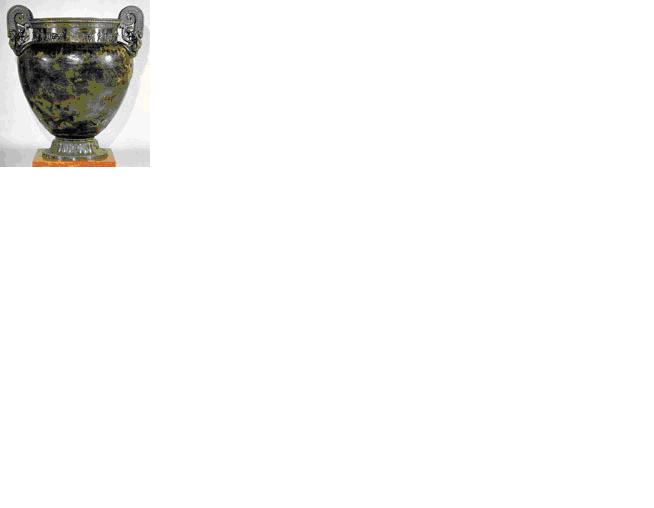
Image |
|
Name @ Provenance:
Krater, from Vix
Findspot @ Date:
grave of a Celtic princess, c. 570 –
560BC.
Material @ Size:
Bronze, 5ft. 4.5in
Present Location:
Chatillon-sur-Seine
Museum
Description:
Handles decorated with Gorgon heads and lions, continuous relief below the rim
like an Ionic frieze. Four hourse chariots w/ charioteers alternate w/ dismounted
warriors in repeated groups.
Interpretation:
Evidence for a trade network reaching up and down the rivers of France,
suggesting interest of non-Greeks in Greek goods. |
| |
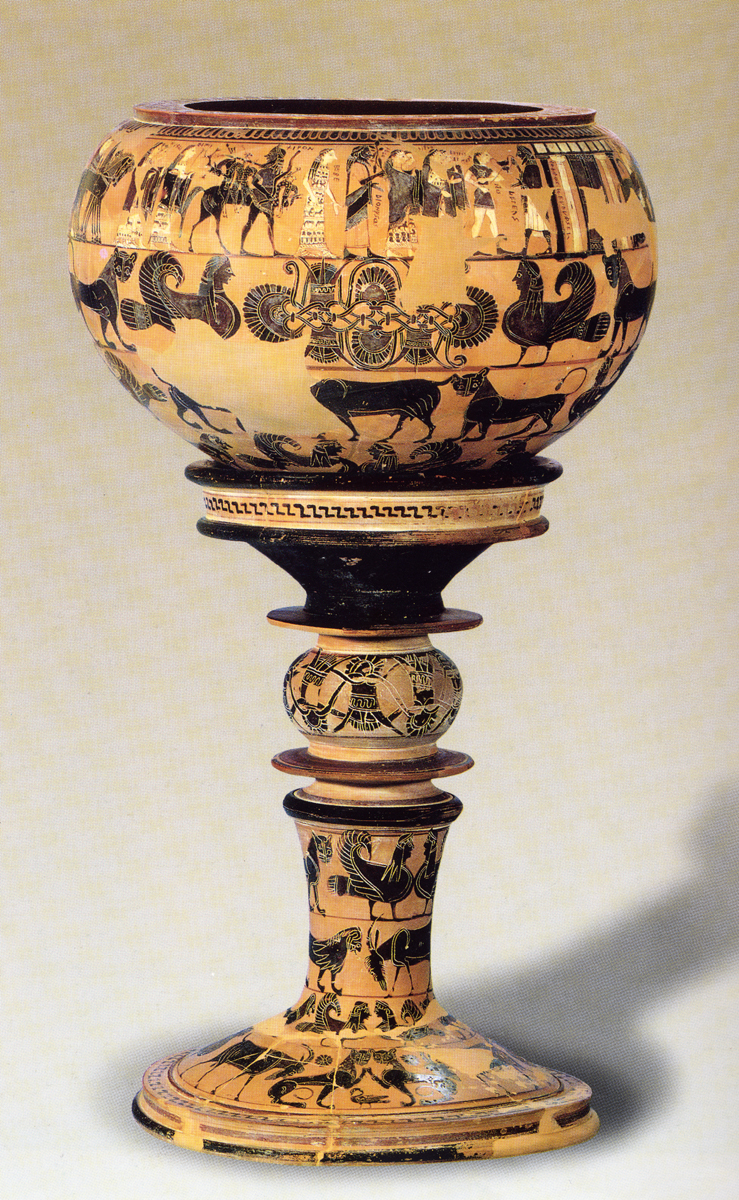
Image |
|
Name @ Provenance:
Attic black-figure dinos and stand by Sophilos: (dinos) Peleus welcoming gods
to the wedding feast; (stand) Animal Style registers.
Findspot @ Date:
c. 580 BC.
Material @ Size: 3
and 2/5in
Present Location:
British Museum,
London
Description:
Friezes of tightly drawn animals/florals. White and purple colors, the white
always used for women, inscriptions identify individual characters. At house of
Peleus, wedding guests include centaur Chiron and Hebe. Thetis bides her time
inside the house, we can see the façade –Doric columns, purple door, black
antae
Interpretation: Small
scale, black figure technique, mythological stories all typical of first
quarter of the century. Sophilos is the first Attic painter who’se name we
know, decorated this cauldron and its stand. |
| |
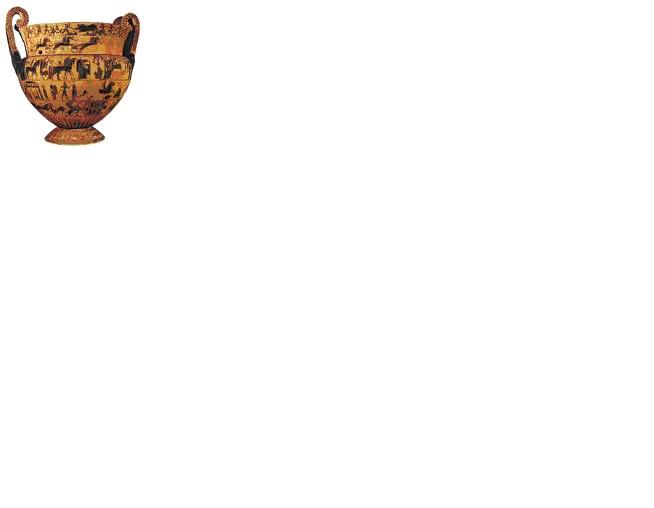
Image |
|
Name @ Provenance: Francois
Vase, Attic black-figure volute krater, by Kleitias and Ergotimos.
Findspot @ Date: c.
570BC.
Material @ Size:
2ft. 2in
Present Location: Archaeological Museum, Florence
Description: From
top: Kalydonian boar hunt; funeral games for Patroklos; marriage of Peleus and
Thetis; ambush of Troilos.
Kleitias drew black-filled figures against the orange-red
background starting with contours, with interior details in black shapes.
Profile, three-quarter, and even frontal views of figures are shown.
Interpretation: Kleitias
used architecture – the house of Peleus, the fountain house, walls of Troy – to suggest locale
and punctuate compositions. Human body depicted in varied motions and space.
Overlapping suggests depth. A model of draftsmanship and composition, encyclopedia
of mythological events. |
| |
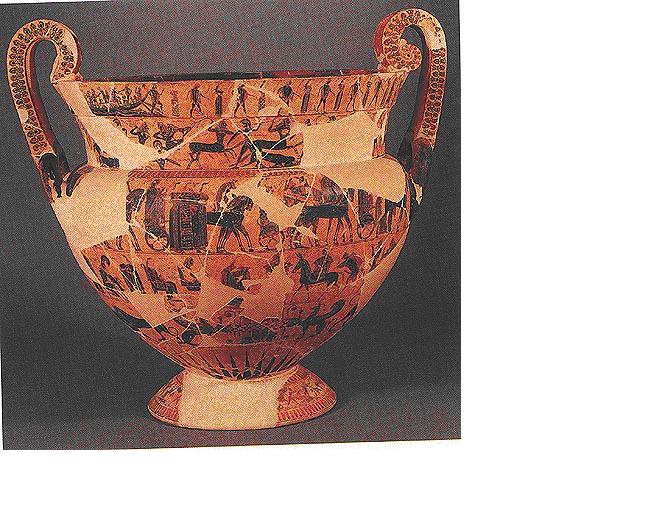
Image |
|
Name @ Provenance: Other side of
Francois Vase (as above)
Findspot @ Date: c.
570BC.
Material @ Size: 2ft.
2in
Present Location: Archaeological
Museum, Florence
Description: From
the top: arrival of Athenians; centauromachy; marriage of Peleus and Thetis;
return of Hephaistos to Olympus
Interpretation: Kleitias
used architecture – the house of Peleus, the fountain house, walls of Troy – to suggest locale
and punctuate compositions. Human body depicted in varied motions and space.
Overlapping suggests depth. A model of draftsmanship and composition,
encyclopedia of mythological events. |
| |
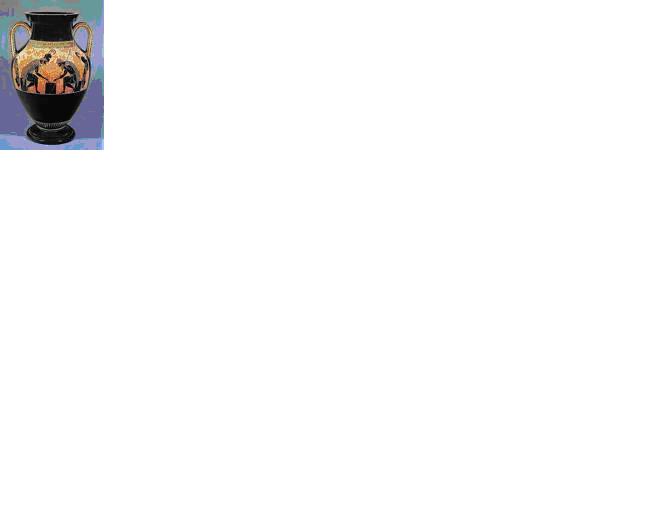
Image |
|
Name @ Provenance: Attic
black-figure amphora by Exekias
Findspot @ Date: c.
540-530BC.
Material @ Size: 2ft.
Present Location:
Vatican Museum,
Rome
Description: Ajax and Achilles playing
a game. Excellence of draftsmanship and brushwork, control of detail, balance
and power of composition.
Interpretation:
Both men are armed, ready for battle so we know they are Troy. Achilles is sitting out because of his
anger, but the viewer knows he will return, and knows of the dire events
(Patroclus’ death) which are to follow. Peaceful scene is full of foreboding.
New motifs of everyday life and social commentary… |
| |
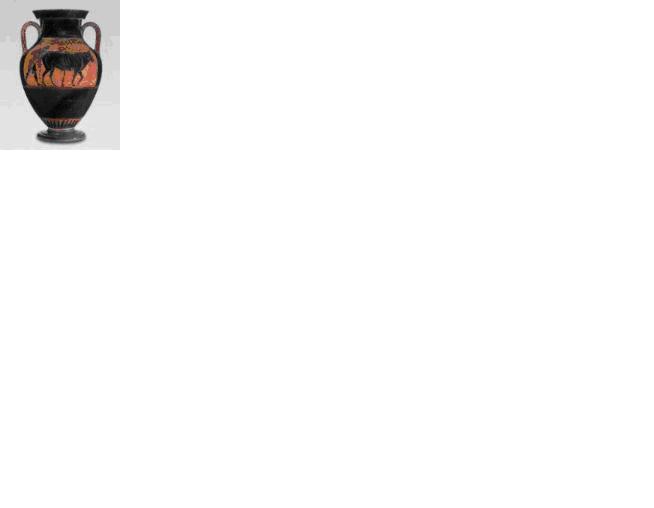
Image |
|
Name @ Provenance:
Attic bilingual (black-figure and red-figure) amphora from Andokides’ workshop.
Findspot @ Date:
c. 520BC.
Material @ Size:
21in
Present Location:
Museum of Fine
Arts, Boston
Description:
Herakles driving a bull. Image appears on one side in red and one side in black
figure.
Interpretation:
Introduction of red-figure, in which the background clay is painted black, but
the figure remains red. Bilingual shows artists’ versatility |
| |
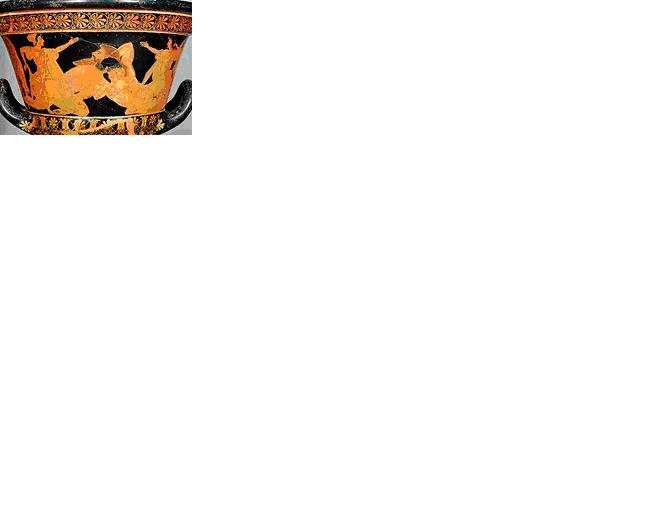
Image |
|
Name @ Provenance:
Attic red-figure calyx krater by Euphronios
Findspot @ Date:
c. 510BC
Material @ Size:
19in.
Present Location:
Musee de Louvre, Paris
Description:
Heracles struggling with Antaios; Herakes wrestles the giant in a n
uncomfortable pose. One of Antaios’s arms hangs limp and he grits his teeth.
Interpretation: Made
by one of the Andokides Painter’s or “pioneers” who made daring attempts at new
poses. Euphronios painted awkward poses and emotional states, and liked
anatomical detail of bone, muscle, flesh, and veins.
|
| |
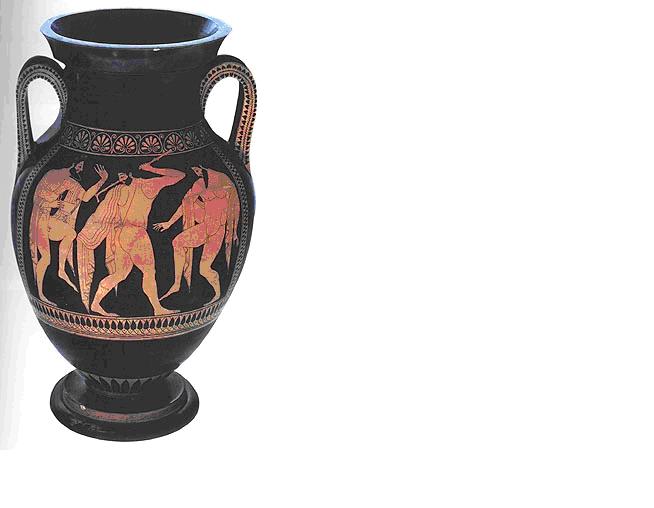
Image |
|
Name @ Provenance: Attic
red-figure amphora by Euthymides
Findspot @ Date:
c. 510
Material @ Size: 23
and 3/5in.
Present Location: Staatliche
Antikensammlungen, Munich
Description:
Revelers; shows older bearded men at their revels. Gestures and poses varied,
relief lines and dilute glaze lines explore body motion. On the amphora
Euthymides challenged his rival, writing “Euphronios never managed anything
like this”
Interpretation:
Led the way in showing interest in motion even if his twisting back view fails.
|
| |
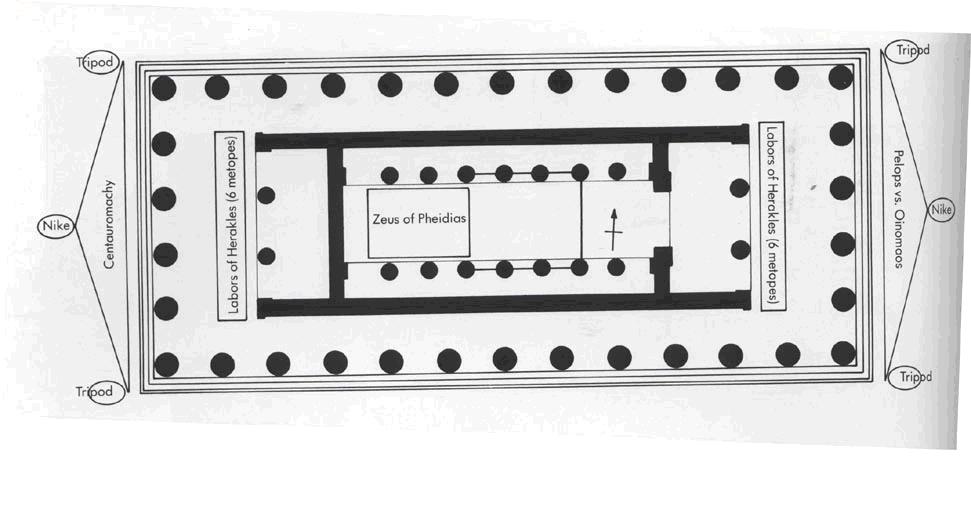
Image |
|
Name @ Provenance: Plan
of the Sanctuary of Zeus at Olympia |
| |
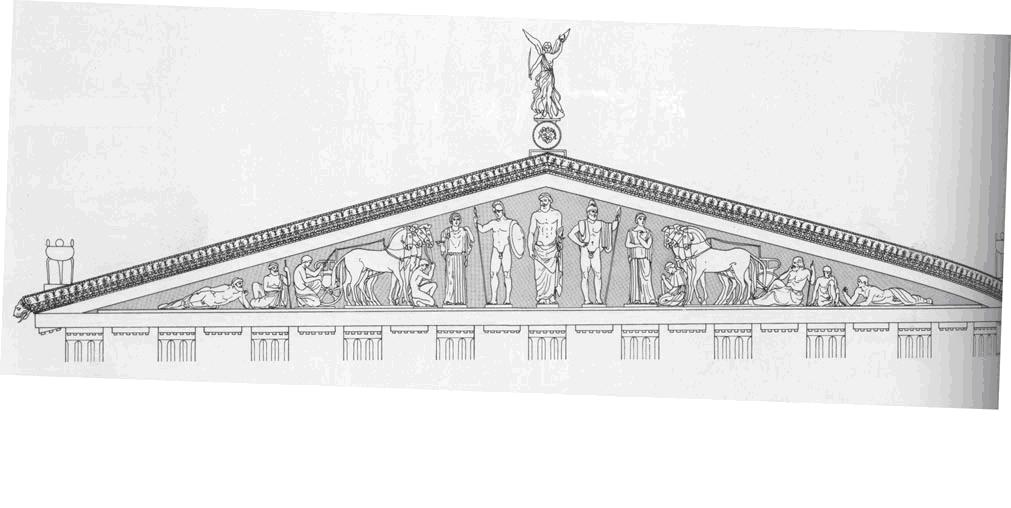
Image |
|
Name @ Provenance:
Temple of Zeus, east pediment
Findspot @ Date: Olympia, c. 460BC.
Material @ Size:
11ft.
Preservation: Reconstructed
picture
Description:
Shows preparations for the chariot race between Pelops and King Oinomaos who
stand at either side of main figure of Zeus flanked by womenfolk, grooms, and
chariots.
Interpretation:
Scholars debate which side the figures were on of Zeus. Story was appropriate
for Olympia
since Pelops had long been worshiped there. Subject of a chariot race was well
suited for the site of the Olympics, and Zeus is present as judge. But, if you
know the real story – Pelops trick to win/ killing the king – the scene is full
of foreboding. |
| |
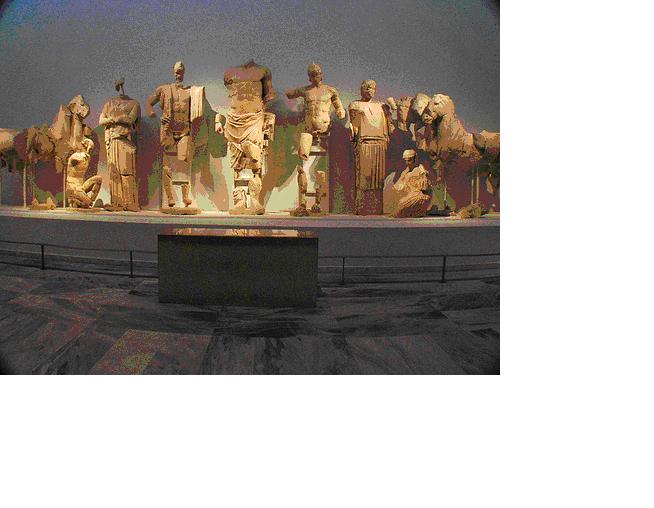
Image |
|
Name @ Provenance:
Temple of Zeus,
Olympia, east
pediment, central figures
Findspot @ Date: c.
460BC
Material @ Size:
Marble, Zeus – 10ft. 2.5in.
Preservation: Shows
most recent arrangement of figures
Present Location:
Olympia Museum
Description: Poses
of central group, all standing separately impart sense of tranquility (ironic).
Five figures leave Archaic pose behind – full of movement, which is expressed
partly through the way the sculptor throws weight onto one leg. Gestures vary.
Women wear peplos (showing change in fashion).
Interpretation: Style
shows action |
| |
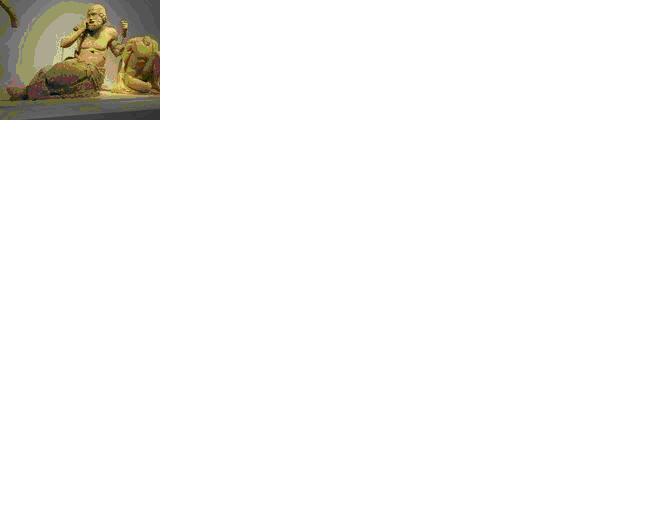
Image |
|
Name @ Provenance: Temple of Zeus,
Olympia, east
pediment: the seer Iamos
Findspot @ Date: c.
460BC
Material @ Size: Marble,
4ft. 6in.
Preservation: Right
knee lost as is his staff
Present Location: Olympia Museum
Description: Iamos
was resident prophet in Oinomao’s house. Age is shown in full, heavy flesh,
anxiety in brow, balding head, anxiety pressing hand to his face.
Interpretation: Expressiveness
is new in Greek sculpture |
| |
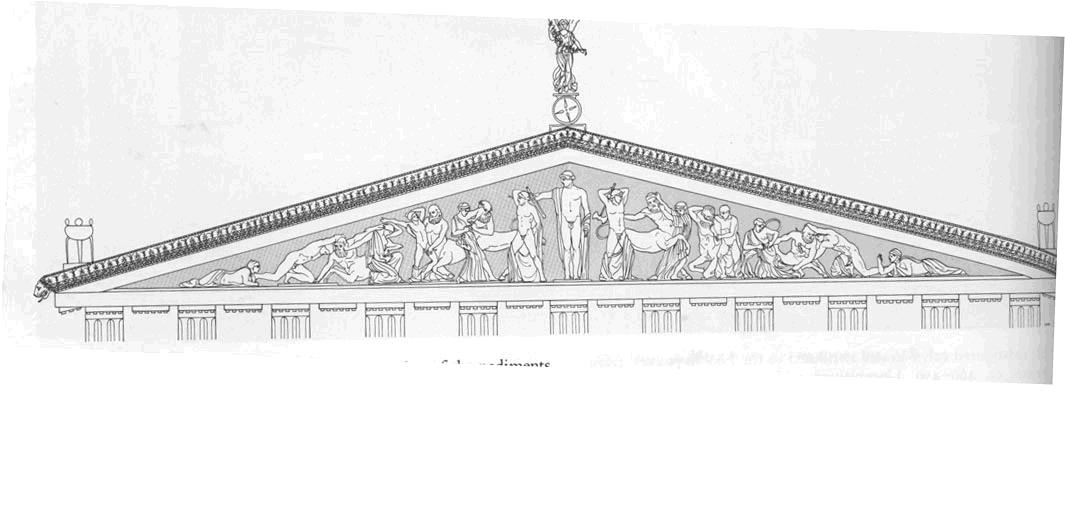
Image |
|
Name @ Provenance: Temple of Zeus,
Olympia, west
pediment
Findspot @ Date:
c. 460BC.
Material @ Size: Height
11ft.
Present Location:
Olympia Museum
Description: Lapiths and centaurs fight at the wedding of
Peirithoos. Apollo is the central figure presiding over the fight, invisible to
the fighters.
Interpretation: References
to Athens,
perhaps showing political sympathy. For those who know the myth, they know that
the Lapiths will defeat the Centaurs, another example of the victory of the
civilized over the barbaric. |
| |
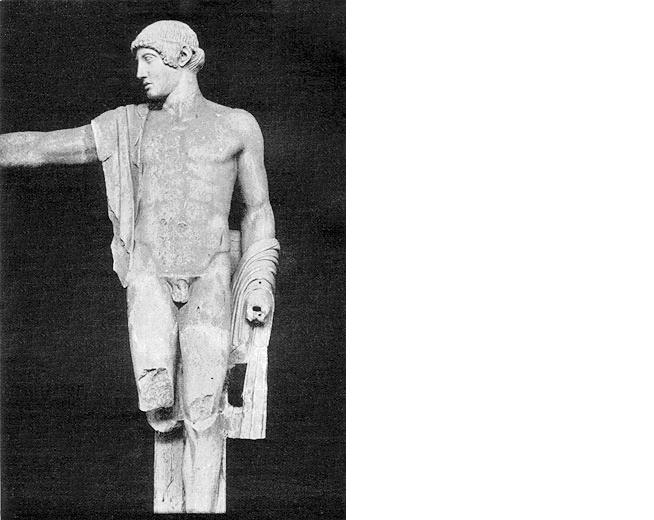
Image |
|
Name @ Provenance: Temple of Zeus,
Olympia, west
pediment: Apollo
Findspot @ Date: 460BC.
Material @ Size:
Marble, Height 10ft. 8in.
Present Location: Olympia Museum
Description:
Impassive expression, arm outstretched symbolic of the range of his control,
torso framed by drapery. Big chin, flat cheeks, eyes bulging between pronounced
lids = stern expression on his heavy face.
Interpretation: Expression
on face characteristic of this period |
| |
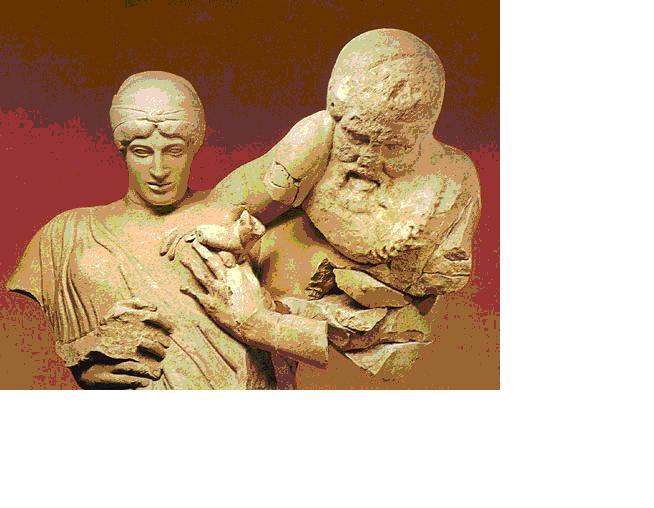
Image |
|
Name @ Provenance:
Temple of Zeus,
Olympia, west
pediment: centaur grappling with Lapith woman
Findspot @ Date: 460BC.
Material @ Size:
Marble, 7ft. 8in
Present Location:
Olympia Museum
Description: Centaur
grips a Lapith woman with his hands and a hoof. She calmly resists, left elbow
banging into his temple.
Interpretation:
Demonstrate many aspects of the contemporary interest in movement, emotion,
narrative, and realism. Faces show character as well as mood. |
| |
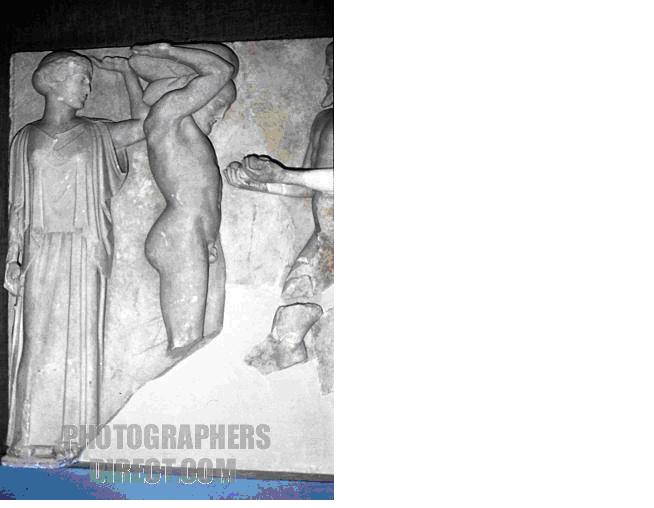
Image |
|
Name @ Provenance:
Temple of Zeus
at Olympia,
reconstruction drawing of a metope and adjacent triglyphs
Findspot @ Date: 460BC.
Preservation: Reconstruction
drawing
Description:
Metopes were positioned over the front and back porches. Athena, Herakles
supporting the heavens, and Atlas bringing the apples of the Hesperides.
Interpretation: The
Metopes illustrate the labors of Herakles, beginning with the first in the back
when he is young and ending with the last when he is older in the front. |
| |
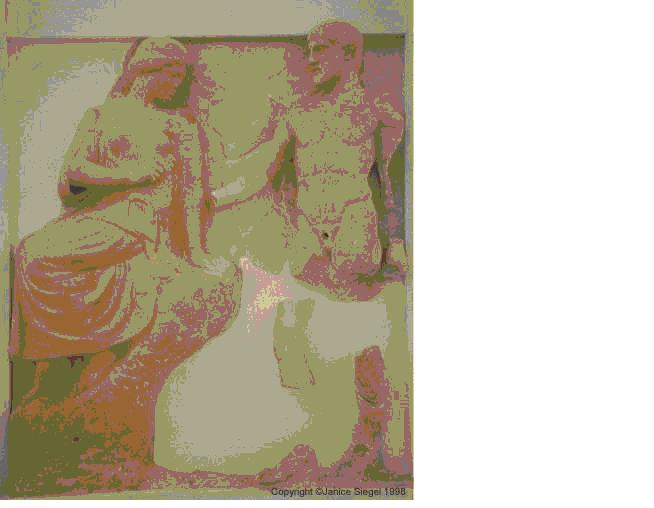
Image |
|
Name @ Provenance:
Temple of Zeus,
Olympia,
metope: herakles, Athena, and the Stymphalian Birds
Findspot @ Date:
460BC.
Material @ Size:
Marble, 5ft. 3in
Present Location:
Olympia Museum
Description:
Seated Athena barefoot on a rock, turns to receive the Stymphalian Birds from
Herakles. She is turning – new design, and he is partly in profile with his
torso in full view. He is calm, she is gentle. |
| |
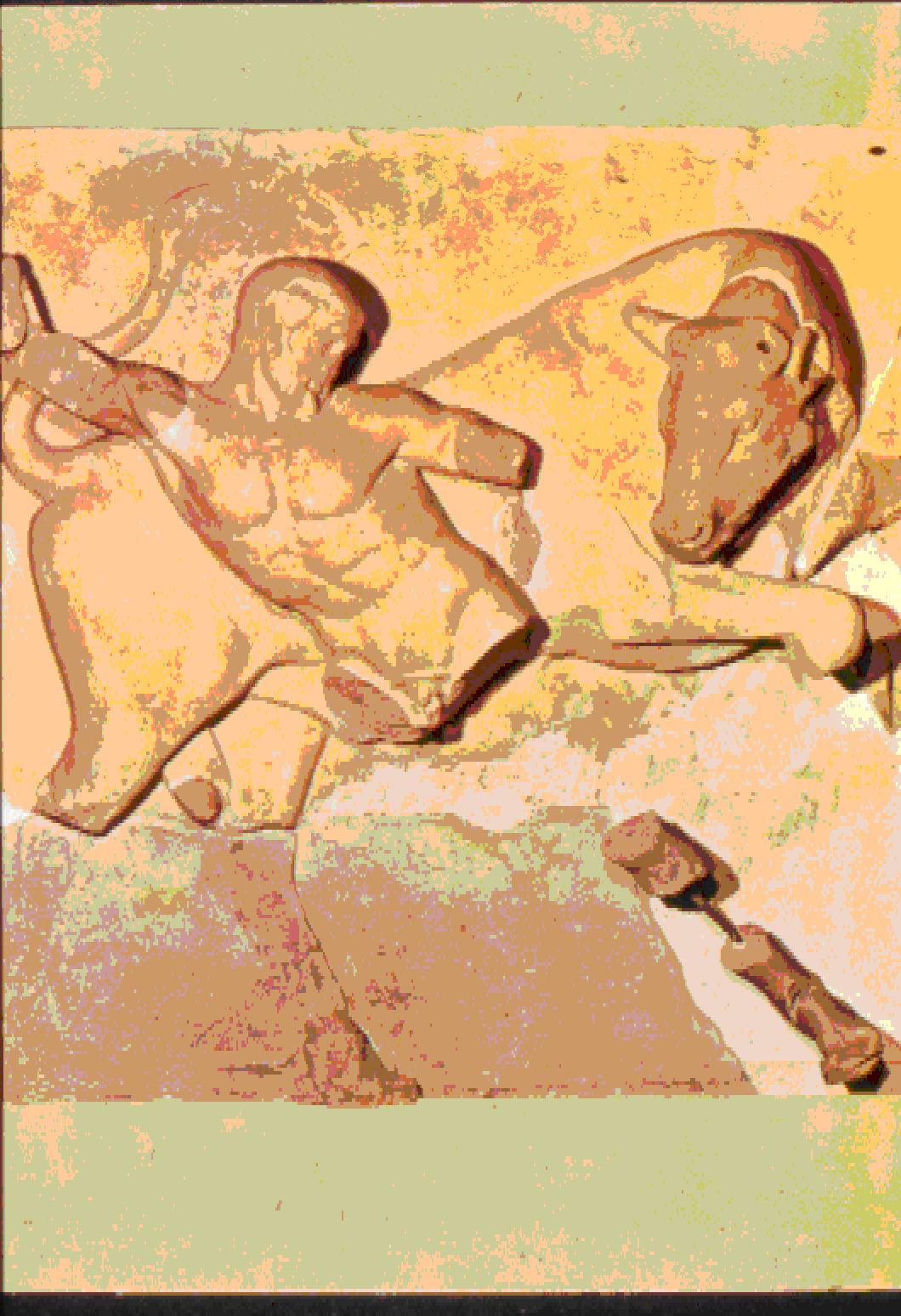
Image |
|
Name @ Provenance: Temple of Zeus,
Olympia,
metope: Herakles and the Cretan Bull
Findspot @ Date:
460BC.
Material @ Size:
Marble, 5ft. 3in
Present Location:
Olympia Museum
Description:
Action. Needed to portray the bull as bigger than Herakles, but he had to be as
big as the other metopes. Bull bigger than the metope, pulling its head from
the background. Herakles and the bull are both turning towards each other.
Whole carving only 15in thick. |
| |
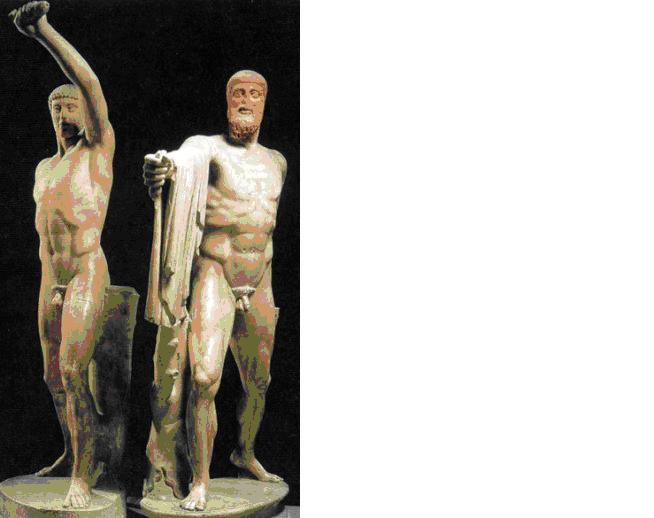
Image |
|
THIS IS NOT ON THE TEST
Name @ Provenance: The
Tyrannicides. Roman copies of c. 477BC. Greek bronzes by Kritios and Nesiotes.
Material @ Size: Marble,
6ft. 5in
Present Location:
National Museum,
Naples
Description:
Arrangement of the figures is controversial. Older man, Aristogeiton, lunges
forwards arm outstretched with a hanging cloak on it. Severe style hair and
face. Younger man, Harmodios, moves forward with a raised weapon. Typically
archaic hairstyle with sever style face.
Interpretation: Profesor
Symeonoglou’s weird hypothesis…
|
| |
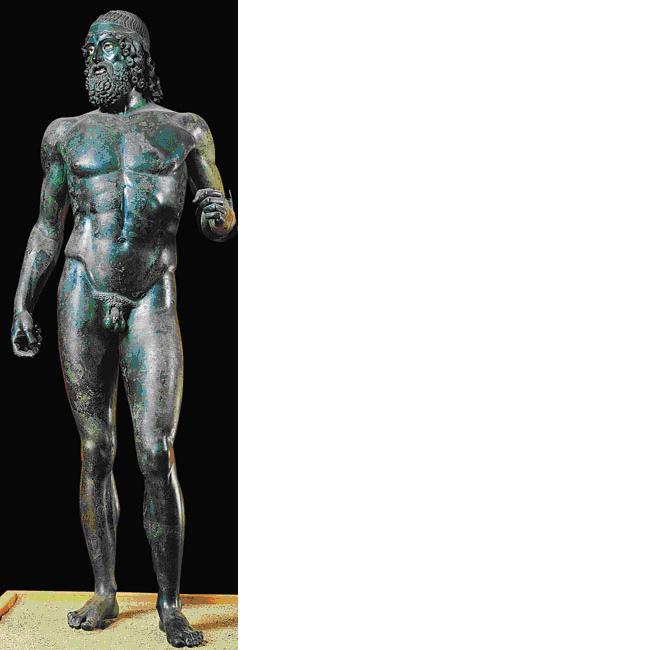
Image |
|
Name @ Provenance:
Riace Warrior A.
Findspot @ Date:
c. 460-450BC.
Material @ Size:
Bronze with copper lips and nipples, silver teeth, and eyes inlaid; 6ft 9in
Present Location:
National Museum, Reggio Calabria
Description: The
younger man, appears energetic, challenging, almost arrogant through body
language, facial expression, and angle of head. Originally carried a shield and
spear, may have worn a wreath. Hips tilt one way, shoulders the other, and head
turned challengingly to the right.
Interpretation:
Probably represent Greek heroes and were originally offerings either at Delphi
or Olympia.
Controversial who made them. Clay comes from Argos. |
| |
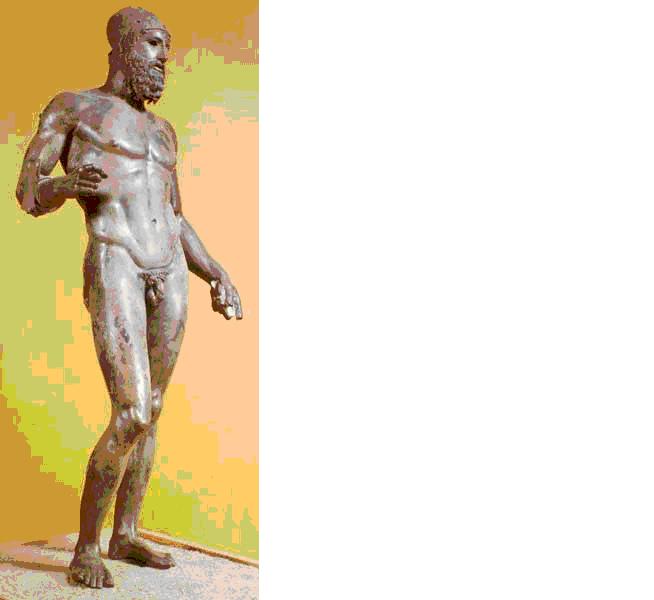
Image |
|
Name @ Provenance:
Riace Warrior B
Findspot @ Date:
c. 460-450BC.
Material @ Size:
Bronze with copper lips and nipples, silver teeth, and eyes inlaid; 6ft 9in
Present Location:
National Museum, Reggio Calabria
Description:
Relaxed, calm, almost resigned. Originally carried a shield and spear and wore
a helmet. Figure sways to the right and left knee advances the front plane.
Stylistically more advanced and engaged in space than his counterpart.
Interpretation:
Striking in the way the sculptor(s) explored mood. Both A and B were fished out
of the ocean near Riace in South Italy. May
have come from a shipwreck of a merchant ship. |
| |
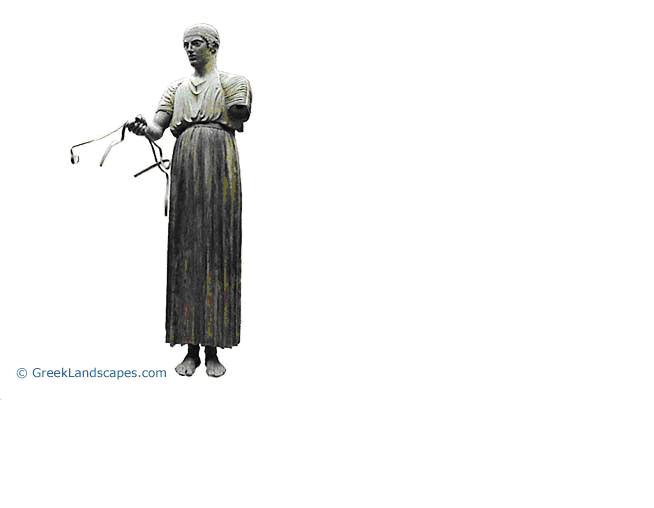
Image |
|
Name @ Provenance:
Charioteer at Delphi
Findspot @ Date:
c. 478 or 474BC.
Material @ Size:
Bronze with copper(lips, eyelashes), silver(teeth, headband), and onyx eyes;
height 5ft. 11in
Present Location:
Delphi Museum
Description:
Originally part of a large group consisting horses, chariot, charioteer, groom.
Cast in eight pieces. Incorporation of other metals and materials speaks to
their love of color. Weight is evenly distributed, most of lower body lost
behind folds, static and columnar. Slight movement of upper body, tension of
outstretched arm, and open mouth all show the aftermath of the race.
Interpretation: A
gift of a Sicilian Greek, Polyzalos, tyrant of Gela, to the sanctuary for victory in the
chariot race of ’78 or ’74. |
| |
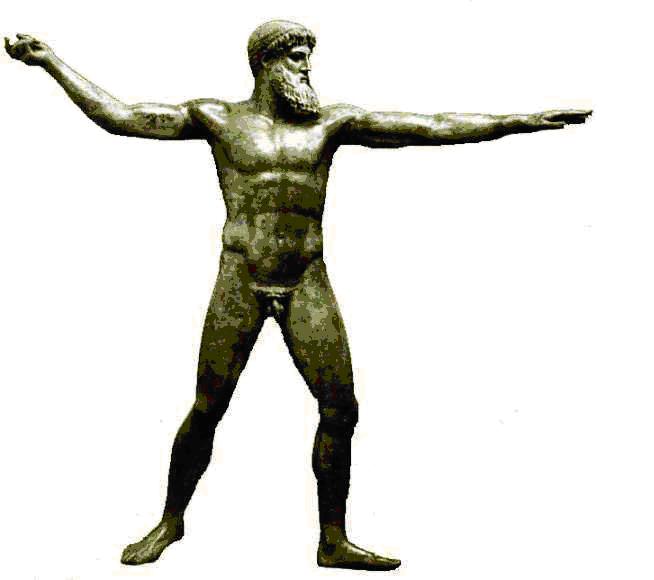
Image |
|
Name @ Provenance: Artemision
Zeus or Poseidon,
Findspot @ Date: Sea
near Cape Artemision, c. 460-450BC.
Material @ Size:
Bronze, 6ft. 10.5in.
Present Location:
National Museum,
Athens
Description: Identification
of the god depends on what he holds in his right hand (thunderbolt or trident).
Arms outstretched, aims to hurl his weapon. Limbs are long, no movement of
upper body. Plastic movement of hair on forehead. |
| |
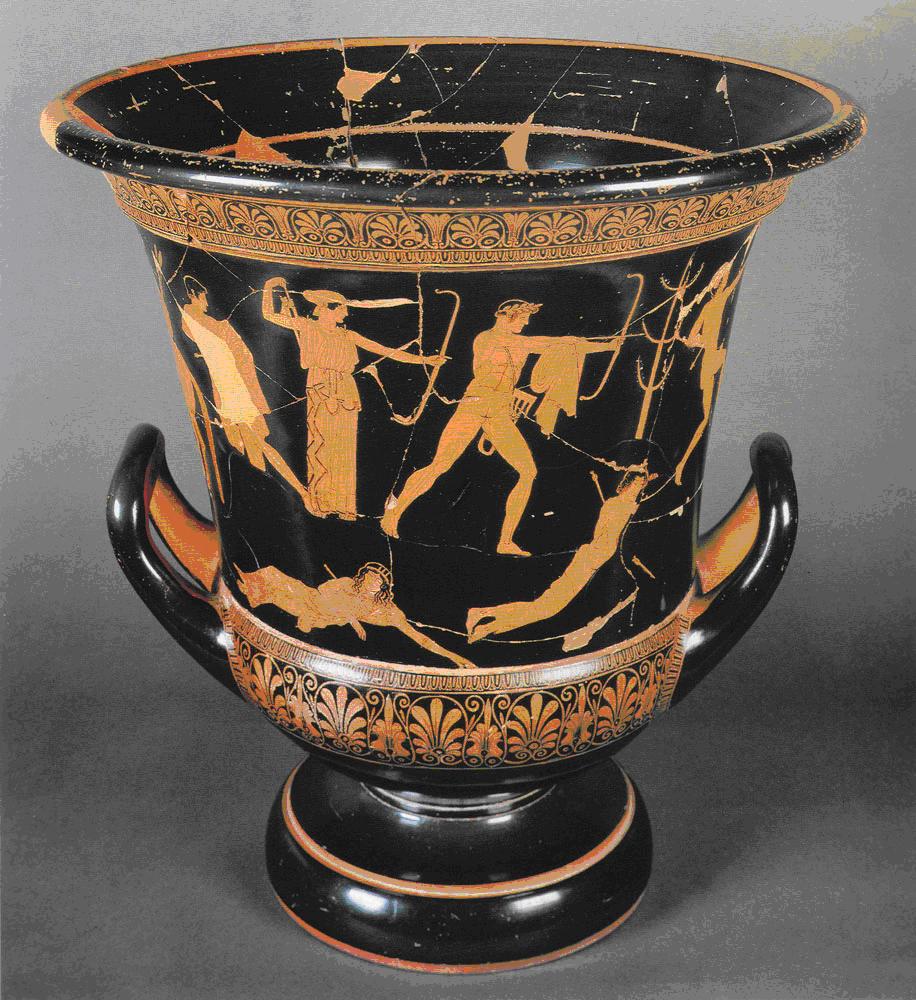
Image |
|
Name @ Provenance:
Attic red-figure krater by the Niobid Painter
Findspot @ Date:
460BC.
Material @ Size:
21.25in.
Present Location:
Musee du Louvre, Paris
Description: Apollo
and Artemis killing Niobe’s children; Niobe brags about the great number of
children she has and her hubris is punished. One Niobid takes an arrow in the
back; the others are dead or dying. Three quarter and intermediate views shown
successfully. Profile of the eye at last appears. Figures in various postures
an don various wavy groundlines.
Interpretation:
Old convention of single groundline has been replaced by multiple ones, to show
depth; no reduction of size in figures that are theoretically in the distance,
though. |
| |

Image |
|
Name @ Provenance:
Attic red-figure krater by the Niobid Painter; reverse side
Findspot @ Date:
460BC.
Material @ Size:
21.25in.
Present Location:
Musee du Louvre, Paris
Description:
Athena, Herakles,, and heroes; arranged over the surface, top and bottom. At
ease in contrast with the active violence on the other side. |
| |
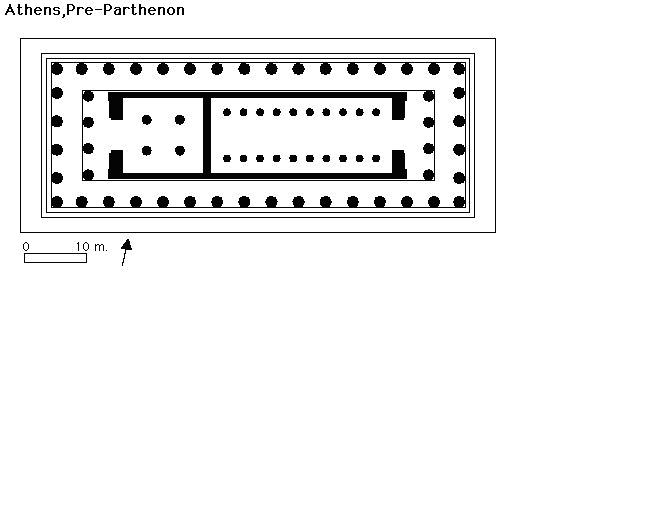
Image |
|
Name @ Provenance:
Plan of the Parthenon, Athens
Findspot @ Date:
c. 447 – 432BC.
Description: Usual
formula for the number of columns was used. A row of columns behind the statue
was a new development. Usual Doric porch arrangement, but Ionic columns were
introduced in the back room where Athena’s treasure was kept. Sculpted ionic frieze
encircled the exterior of the cella, back room, and porches but was so high it
was nearly invisible. |
| |
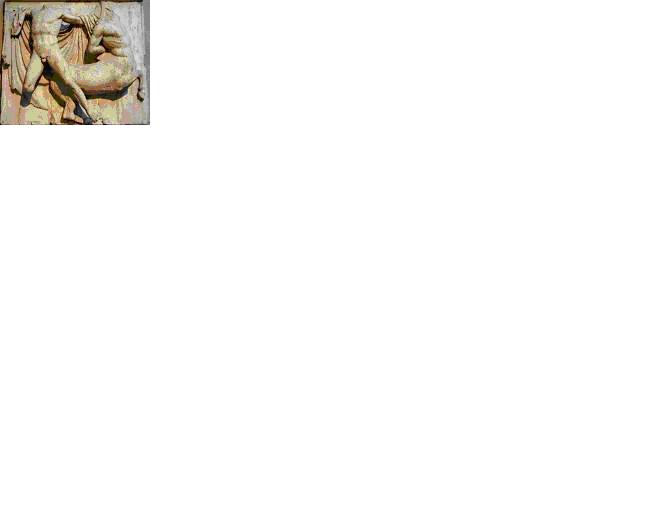
Image |
|
Name @ Provenance:
Parthenon, south metope 27
Findspot @ Date: Athens, 447-438BC.
Material @ Size:
Marble, 4ft. 5in
Present Location:
Parthenon (?)
Description: Struggle
between Lapith and centaur; South metope best preserved, figures clash in
combat, struggle, collapse. Lapith leaping forward and laterally from its
rectangular frame. Dominated by the tension of the fight and drapery folds,
originally painted, that form the backdrop to the human torso.
Interpretation: Good
execution of heavy veined anatomy of the centaur and the flying, slightly
turned Lapith. |
| |
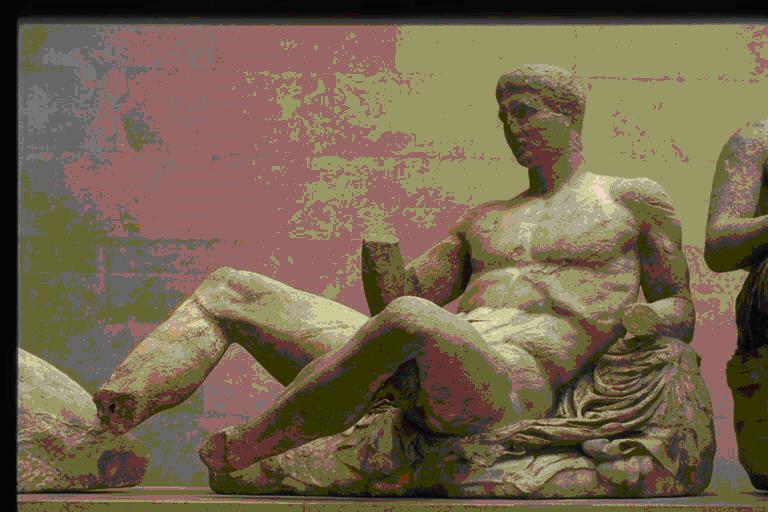
Image |
|
Name @ Provenance:
Parthenon, east pediment: reclining male figure
Findspot @ Date: Athens, 437-432BC.
Material @ Size:
Marble, 4ft. 3in tall
Present Location:
British Museum,
London
Description: Birth
of Athena is central event of this pediment, but surrounding figures have
varying degrees of awareness. This reclining nude gazes at the rising sun,
completely unaware.
Interpretation:
Has been identified as Ares, Dionysos, or Herakles and it has even been
suggested that he is a personification of Mt. Olympus,
showing the place.
|
| |
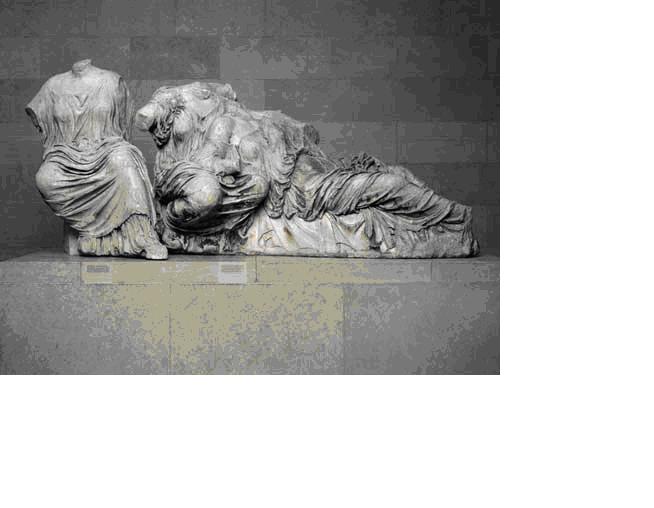
Image |
|
Name @ Provenance:
Parthenon, east pediment: three female figures
Findspot @ Date: Athens, 437-432BC.
Material @ Size:
Marble, 4ft. 5in
Present Location:
British Museum,
London
Description: In
the northern half, a goddess reclines on the lap of another calmly awaiting the
passing of night while a third seated figure turns slowly towards the center.
Chitons and mantles are so deeply carved they create a profound effect on light
and shade.
Interpretation:
Ignorance contrasting with realization, artist shows skill at portraying
thought. |
| |
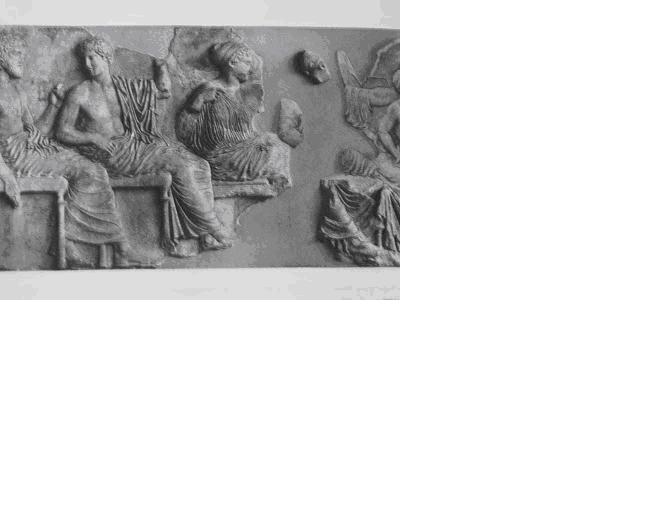
Image |
|
Name @ Provenance:
Parthenon, east frieze: seated deities
Findspot @ Date: Athens, 447-438BC.
Material @ Size:
Marble, 3ft. 6in.
Present Location:
Acropolis Museum,
Athens
Description:
Poseidon, Apollo, Artemis are seated on stools (only Zeus has a throne).
Slightly overlapping one another, legs placed in front of furniture to give a
sense of space.
Interpretation:
Traditional view holds that the frieze represents the Panathenaic procession… |
| |
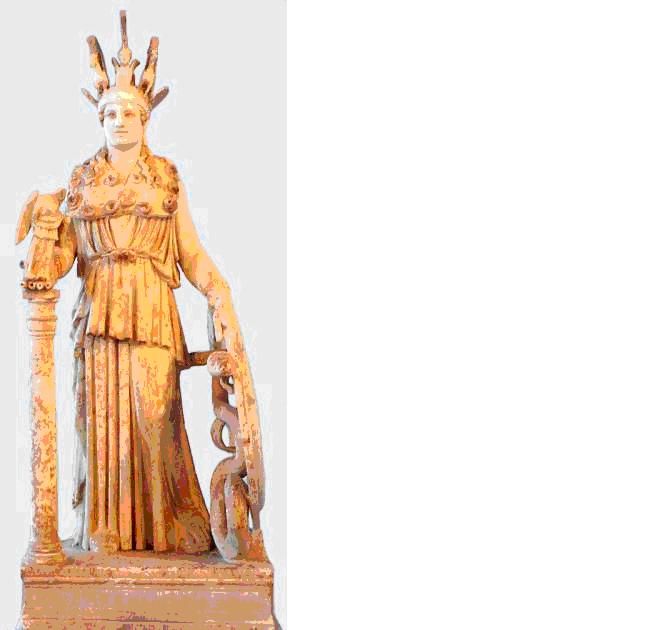
Image |
|
Name @ Provenance:
Varvakeion statuette, a roman version of the statue of Athena Parthenos
Findspot @ Date:
2nd century AD. It is a copy of the gold and ivory statue of Phidias
in 438BC.
Material @ Size: Marble,
3ft. 5.5in
Present Location:
National Museum,
Athens
Description: All
trace of the original statue has vanished but we know about it from literary
descriptions. Originally stood 13 yd. high, wearing an aegis and an elaborate
helmet, holding a Nike and a spear, with a shield and snake nearby.
Interpretation:
This statue gives us an idea of what she might have looked like, but not on the
large scale with the glittering gold and ivory flesh -hard to imagine. A
replica has been installed in Nashville,
Tennessee. The combination of
statue and building must have been awesome. This shows the religious power of
Athena, and the political power of Athens.
|
| |
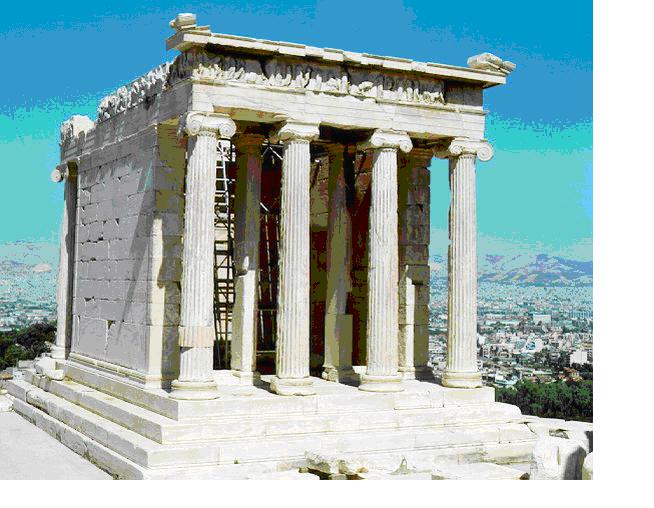
Image |
|
Name @ Provenance: Temple of Athena, Nike (view from the east showing
tetrastyle columns of the façade and monolithic columns)
Findspot @ Date: Athens, 420sBC.
Material @ Size:
Marble, columns 15ft. 3in, enatablature 3ft. 6ins
Present Location:
Athens
Description:
Built high on a bastion overlooking Propylaia, uses Ionic order to contrast
nearby Doric gateway. Cella square, four columns front and back, doorway
flanked by monolithic pillars. A congregation of divinities, seated and
standing, make up east frieze.
Interpretation:
Theme was victory. |
| |
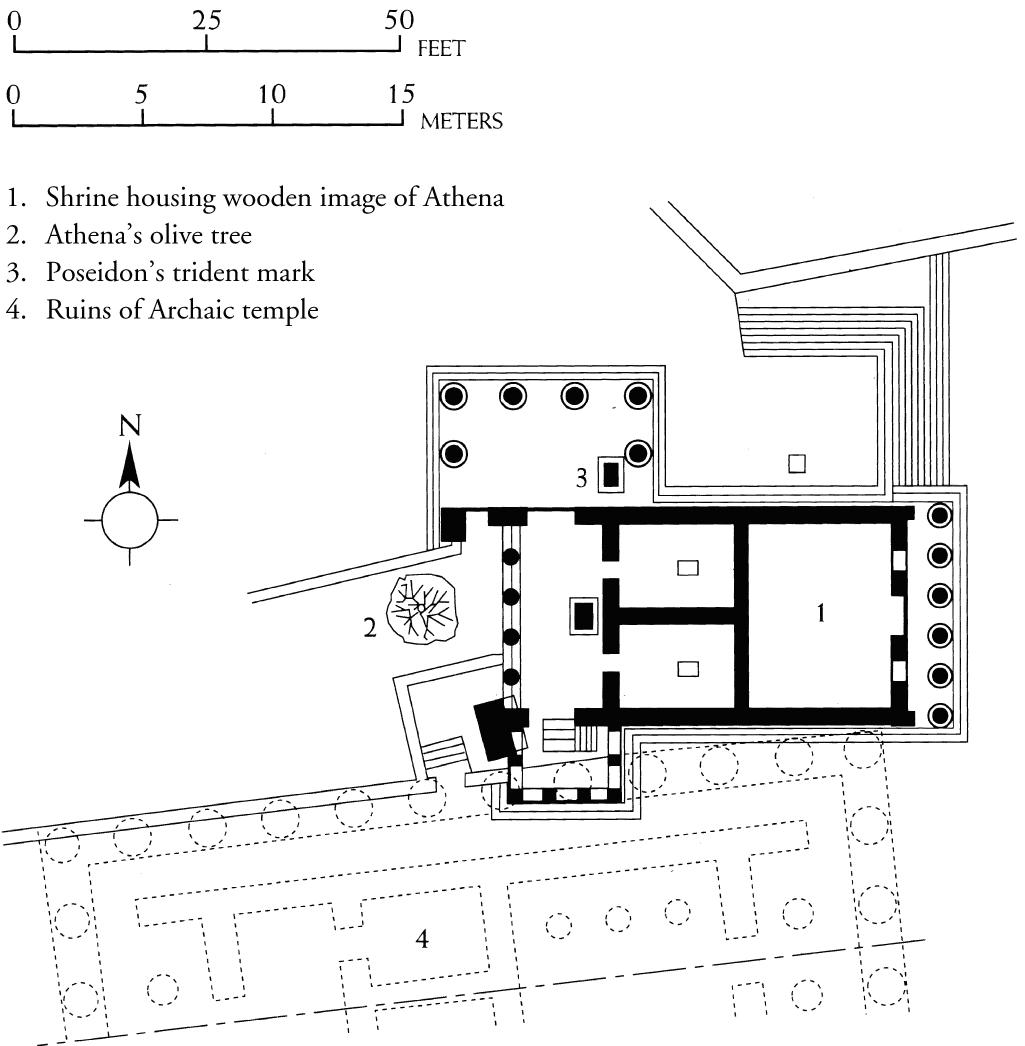
Image |
|
Name @ Provenance: Plan
of the Erechtheion, Athens
Findspot @ Date: c.
430s-406BC.
Description: 1
Athena Polias 2, 3, and 4 Erechtheus, Poseidon, possible Boutes. Interior
arrangement conjectural. Split
level building is unorthodox was occupied at one point by a Mycenaean palace.
Began to be built in 430s, but most construction took place between 409 and
406. The porch on the south side had six female statues (caryatids) standing on
the wall to support the porch’s flat roof.
|
| |
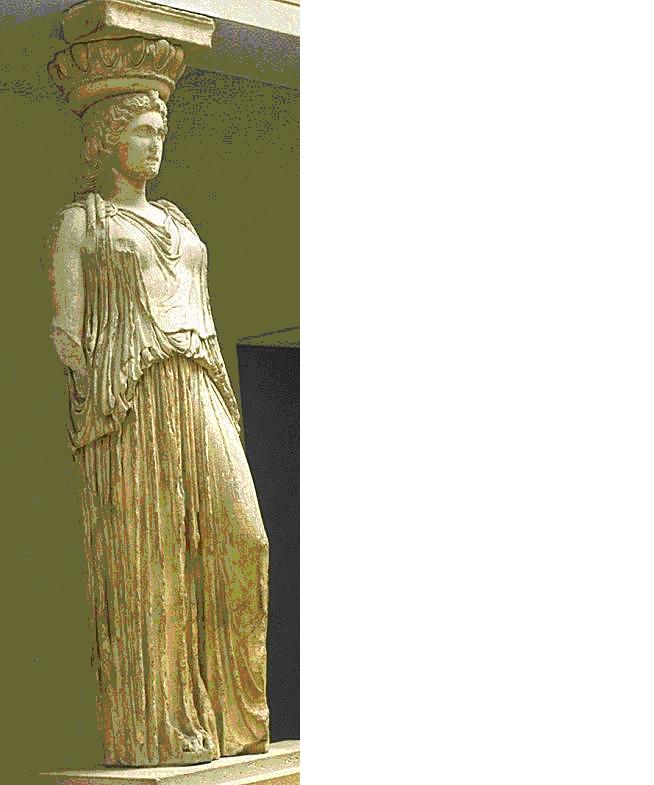
Image |
|
Name @ Provenance: Caryatid
from the south porch of the Erechtheion, Acropolis of Athens
Findspot @ Date:
420-410BC.
Material @ Size:
Marble, 7ft 7in
Present Location: Acropolis Museum,
Athens
Description:
Weight leg lost beneath vertical folds of drapery, free leg pushes forward,
outer legs carry weight of the superstructure while inner legs are relaxed. Big
and beautiful, wear peploi with deep cut folds.
Interpretation: Reminiscent
of the Treasury of the Siphnians at Delphi.
Referred to as korai or maidens. |
| |
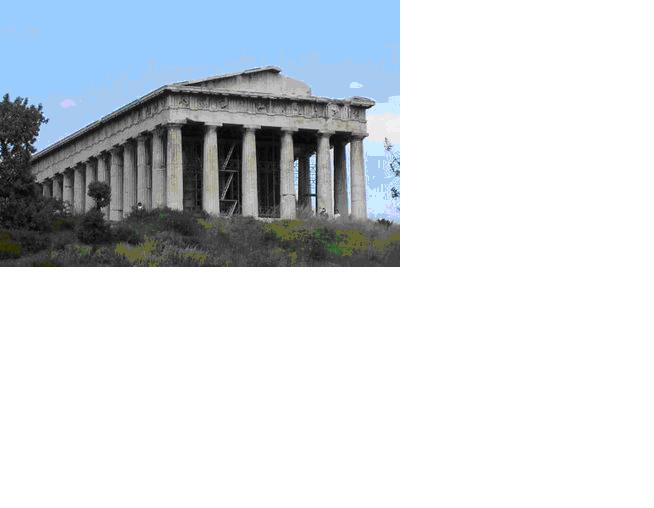
Image |
|
Name @ Provenance:
Hephaisteion, Athens,
from the southwest (carved metopes visible at extreme east)
Findspot @ Date:
c. 450-415BC
Material @ Size:
marble, 18ft 9in.
Description: Temple of Hephaistos, god of metalworking.
Artisans worked here, shared space with
Interpretation:
Best preserved example of a fifth-century temple that we have with the
exception of the lower step of limestone, wooden ceiling beams, and terracotta
roof tiles it is made entirely of marble. |
| |
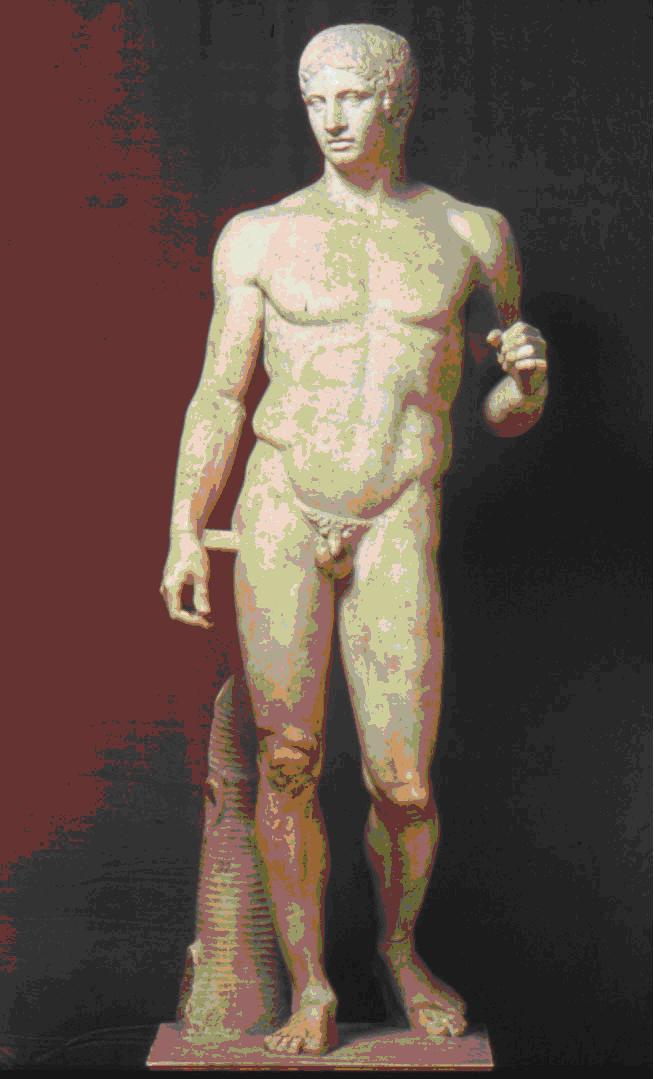
Image |
|
Name @ Provenance:
Doryphoros (spear carrier) by Polykleitos
Findspot @ Date: Pompeii, 440BC. – this is
a Roman marble copy of the Greek original
Material @ Size:
marble, 6ft. 11in.
Present Location:
National Museum,
Naples
Description: Free
leg is placed both laterally and behind, heel raised off ground in “walking
stance”. Distanced, tranquil High Classical expression, weight leg and free leg
balance tensed arm and free arm. Contraposto, realistic, the ideal figure it is
visually accurate.
Interpretation:
More than 50 copies survive. Made by Polykleitos to exemplify his “kanon”, the
identity is not revealed though many think it is Achilles. The perfect body
could represent either gods or men. |
| |
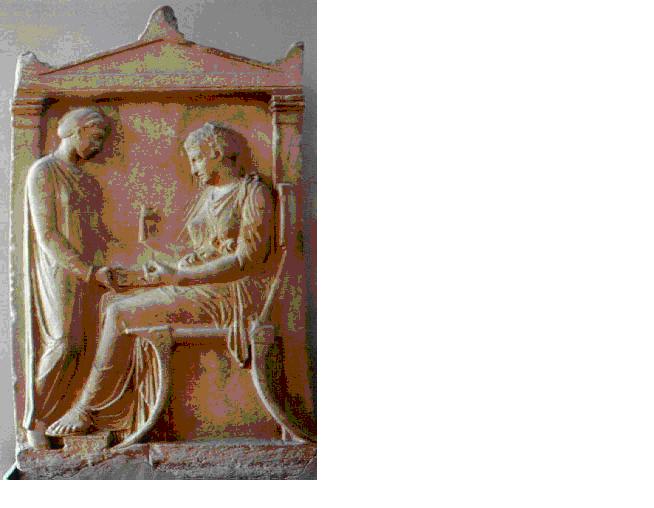
Image |
|
Name @ Provenance: Grave
stele of Hegeso
Findspot @ Date: Athens, 400BC.
Material @ Size:
Marble, 5ft. 2in.
Present Location:
National Museum,
Athens
Description: Hegeso,
well dressed, hair carefully arranged, sits on an elegant chair with a
footstool. With the help of a servant she chooses jewelry from a box. Receding
planes, three quarter and intermediate views. Garments show transparency of
late 5th century art, faces are expressionless. High Classical style
of the Parthenon
Interpretation: Provides
a good example of architectural format (antae and pediment of a door) in front
of which figures sit and stand.
|
| |
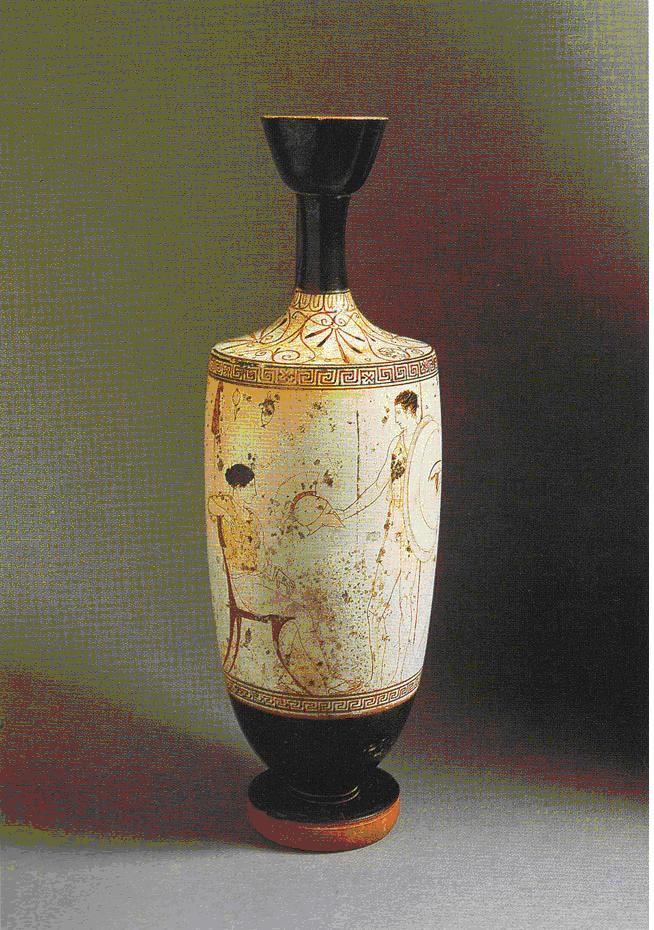
Image |
|
Name @ Provenance:
Attic white-ground lekythos: seated woman in front of a tomb
Findspot @ Date:
410-400BC.
Material @ Size:
20in
Present Location:
British Museum,
London
Description: a
mournful woman seated in front of a tomb. Uses broken contours (arms for
instance) to suggest mass
Interpretation:
White-ground lekyothi generally show scenes appropriate to the funerary
context. |
| |
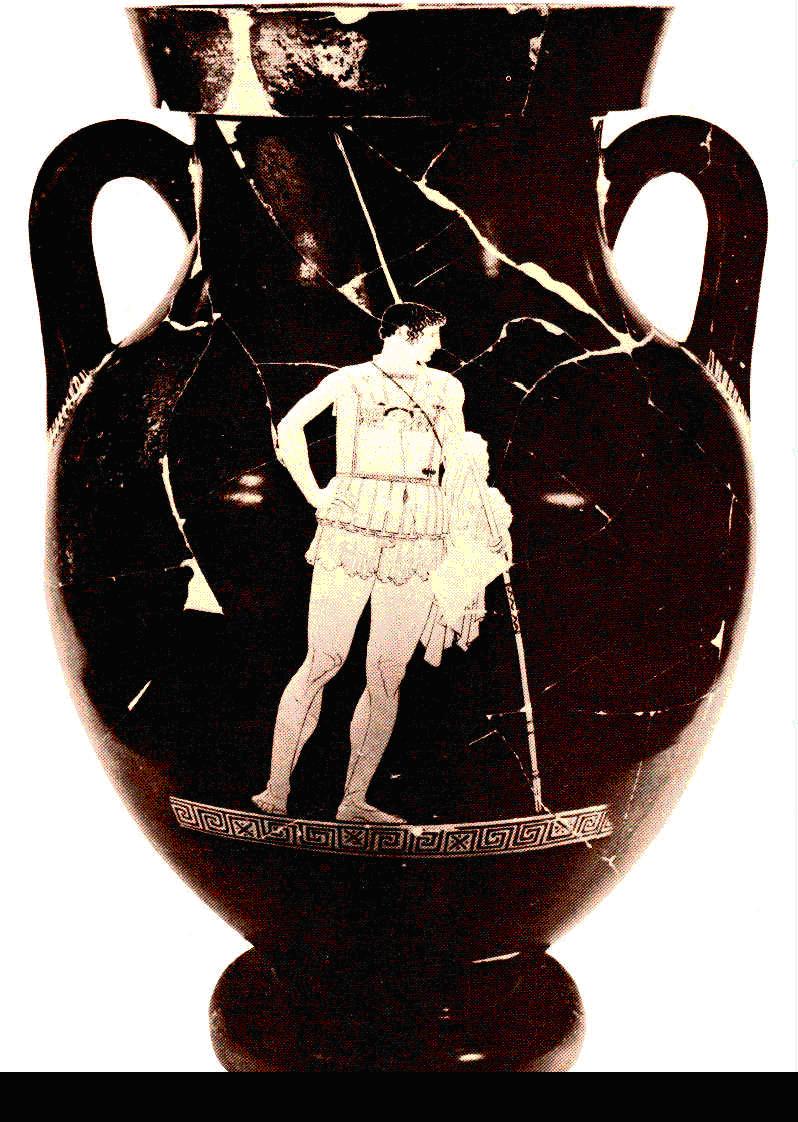
Image |
|
Name @ Provenance:
Attic red-figure amphora by Achilles Painter: Achilles in contraposto
Polykleitan stance
Findspot @ Date:
440 BC.
Material @ Size:
23 and 3/5in
Present Location: Vatican Museum,
Rome
Description: Hero
stands in solitary splendor, maeander groundline, shoulders a spear, right hand
on hip. Accurate representation of anatomy, mood is close to the ideal calm of
Parthenon figures. Contriposto stance.
Interpretation:
Red figure and heroic/mythological scenes become less popular during and after
this time.
|
| |
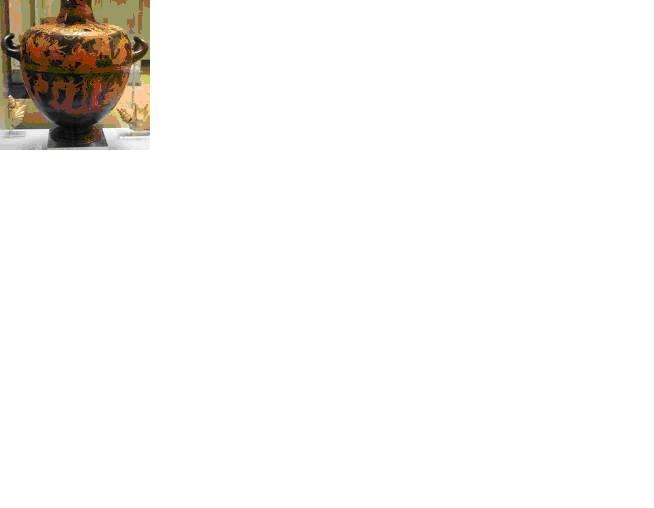
Image |
|
Name @ Provenance:
Attick red figure hydria attributed to the Meidias Painter
Findspot @ Date:
410-400BC.
Material @ Size:
20.5in
Present Location:
British Museum,
London
Description:
Lower register: Herakles in the garden of the Hesperides with tree whose golden
apples were protected by a dragon. Main register: rape of the daughters of
Leucippos; the Dioskouroi and their chariots come to carry off the women.
Pollux is successful, set in the sanctuary of Aphrodite (identified by the cult
statue, landscape, and the goddess herself). Varied poses and gestures, lots of
semi nude women, gilding was used for necklaces, bracelets, and the cult statue.
Interpretation:
Shows the taste for light, flimsy transparent drapery at the end of this
century (also seen in statues). Ease of the painted scenes is at odds with the
tension of the stories shown and the Peloponnesian War that was engulfing Athens. |
| |

Image |
|
Name @ Provenance: Reconstruction
drawing of the interior of the temple
of Apollo
Findspot @ Date:
Bassae, c. 430-490BC.
Description:
Frieze decorated the interior (fights between Greeks and Amazons and Centaurs).
Begun in 430 or so but not finished until 400. Full of innovations: non Doric
interior columns, north south orientation, exterior columns attached to the
wall by masonry spur, and the single column in the middle introduces Corinthian
capital.
|
| |
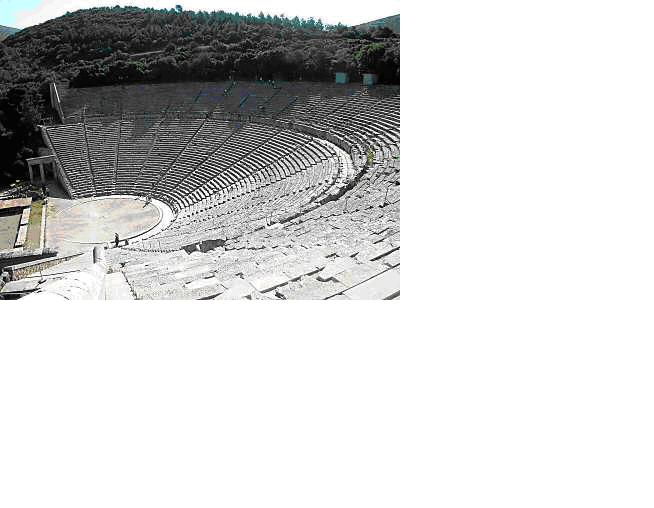
Image |
|
Name @ Provenance:
Theater
Findspot @ Date:
Epidauros, 3rd century BC
Description:
Circular orchestra, skene (dressing rooms), 142 yard auditorium rises up the
hillside. Symmetrically arranged wedges of stone seats, upper and lower
portions separated, fifty five rows of seats, 12000 spectators.
Interpretation:
Dramas were enacted here, closely associated with the cult of Dionysus.
|
| |

Image |
|
Name @ Provenance:
Plan of Olynthos, showing grid layout of streets and housing
Findspot @ Date:
4th – 5th centuries B.C.
Description:
Orthogonal (right angled) grid planning and domestic architecture within a
grid. Urban development, northward of old town, began in late fifth century.
Destroyed by Philip in 348. North-south avenues and east-west streets.
|
| |
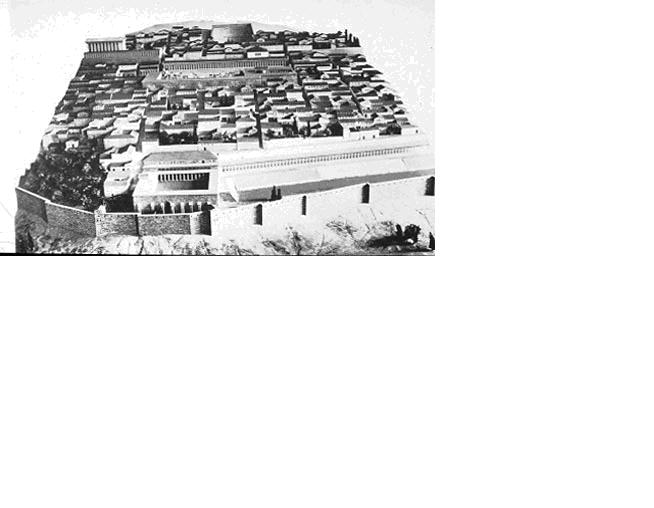
Image |
|
Name @ Provenance:
Priene, model of the hillside town
Findspot @ Date:
4th century BC. and later
Present Location:
Staatliche Museen, Berlin
Description: It
shows grid plan and zoning for agora (center), theater, sanctuaries, council
chamber, and other public uses. Used orthogonal grid implemented on the
hillside. Regularity of spacing of blocks was broken wherever necessary to
accommodate large units. Six blocks in center for agora and other public
buildings.
Interpretation:
Four thousand inhabitants, various house plans. |
| |
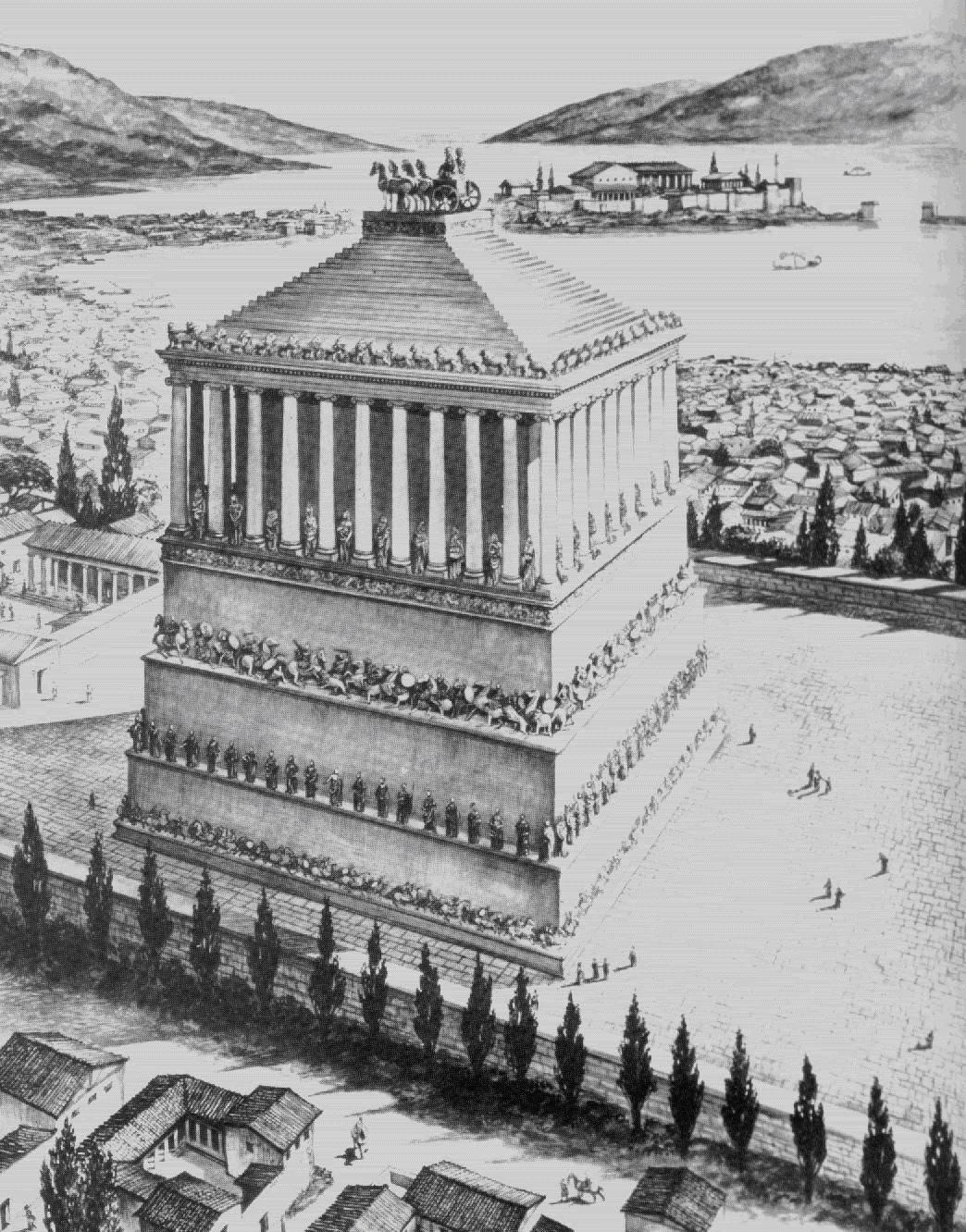
Image |
|
Name @ Provenance:
Conjectured reconstruction of the Mausoleum, Halikarnassos
Findspot @ Date:
350-340BC.
Material @ Size:
Huge 50m. high, 42 yard square base
Description: High
podium supporting a rectangular building with Ionic colonnade, much decorative
sculpture, a pyramid roof, and a four horse chariot on top of the roof. Design
incorporated Egyptian and Persian elements, similarities to the Athena temple
at Priene.
Interpretation:
Descriptions of buildings have led scholars to produce different
reconstructions. Evidence suggests that Mausolos hired Greeks to design and
decorate his tomb. |
| |
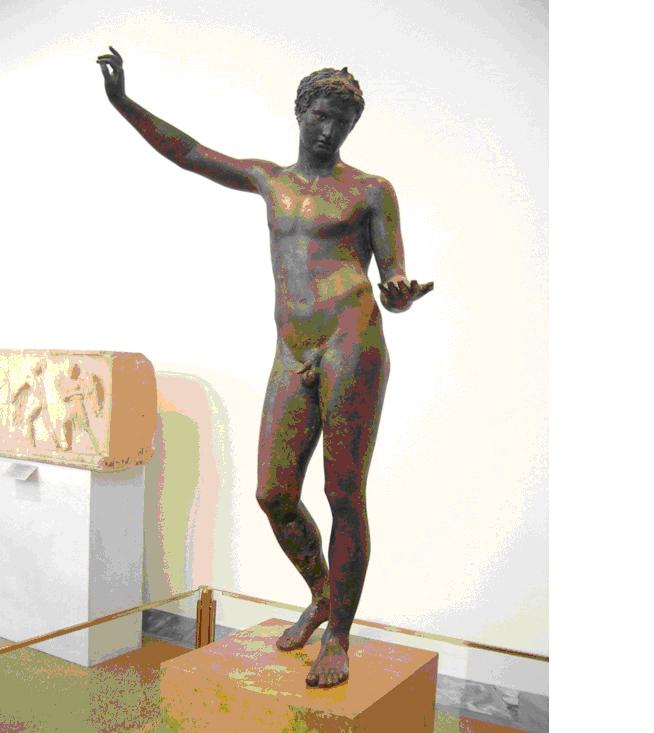
Image |
|
Name @ Provenance: marathon
Boy, recovered from the Bay of marathon in 1925
Findspot @ Date:
c. 340BC.
Material @ Size:
Bronze, 4ft. 3in.
Preservation:
Right arm is Roman repair
Present Location:
National Museum,
Athens
Description:
Under lifesize, weight on left leg, s curve of body- so pronounced that the
volume of the torso carried over to the right unbalances his body. Smooth, soft
limbs suggest youth. He wears a fillet of athletes and palaestra to secure his hair,
but no satisfactory explanation has been provided of his stance. |
| |
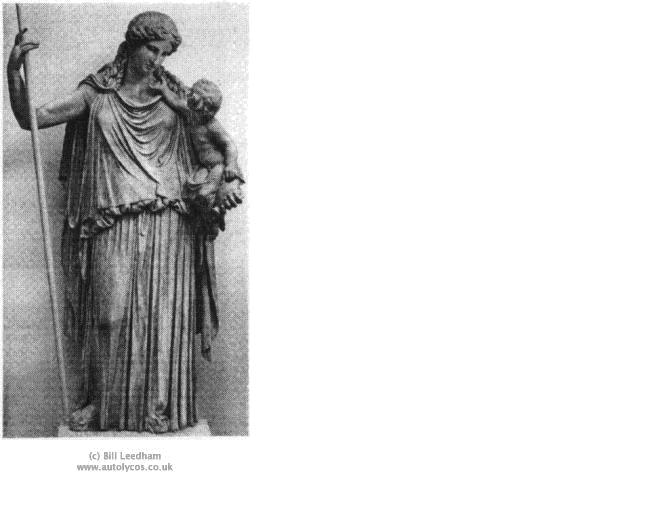
Image |
|
Name @ Provenance: Eirene
(peace) holding the child Ploutos (wealth) by Kephisodotos.
Findspot @ Date: Roman
copy of a c. 370BC
Material @ Size: bronze
Greek original, 6ft. 6in
Present Location:
Staatliche Antikensammlungen, Munich
Description: The
mother, Peace, holds the child, Wealth in the crook of her left arm, while her
right hand originally gripped a scepter. Her stance and massive form echoes
precursors of the High Classical. Heavy Peplos favored by the Transitional
period (480-450). Folds look natural – show actual relationship between body
and cloth. Expression of intimacy towards child.
Interpretation: The original is lost, but later marble copies are
easily recognized thanks to literary descriptions. Allegorical nature of the
group breaks new ground. |
| |
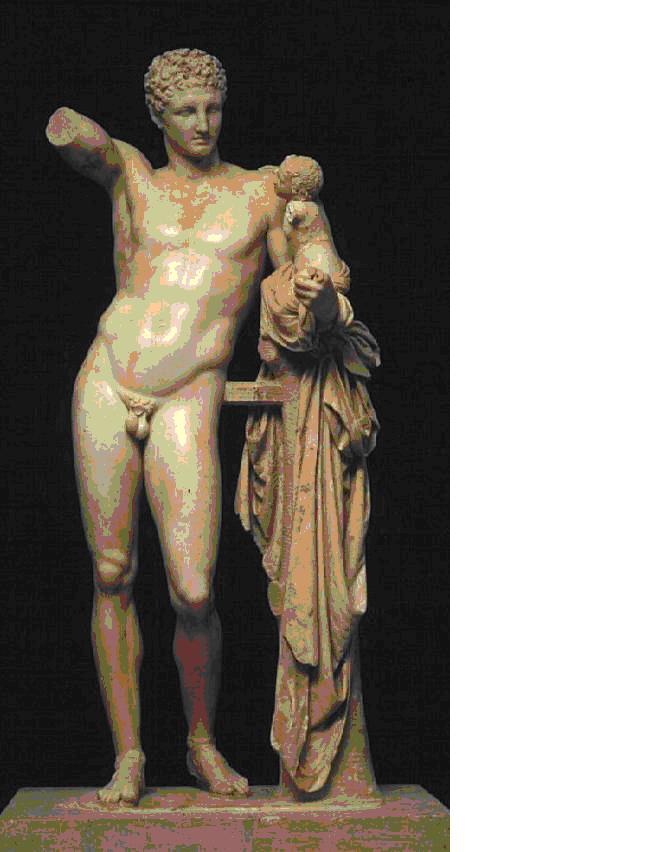
Image |
|
Name @ Provenance: Hermes
and Dionysos by Praxiteles.
Findspot @ Date: Temple of Hera
at Olympia, C.
340 (?) BC.
Material @ Size: Marble,
7ft. 1in.
Present Location:
Olympia Museum
Description: Heavily
influenced by Peace and Wealth statue. Hermes holds the child Dionysos in left
hand, head inclined towards infant. Holds grapes in right hand teasing the
infant. Shown as mortals engaged in mortal activity
Interpretation:
Composition highlights the youth vs. the infant using the old myth. Still some
debate about who made it and if it is a copy. |
| |
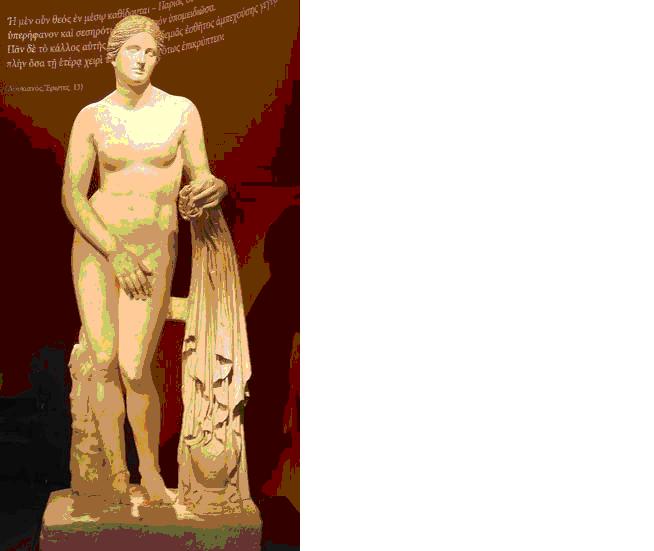
Image |
|
Name @ Provenance: Aphrodite
of Knidos by Praxiteles
Findspot @ Date: Roman
copy of Greek original 350BC.
Material @ Size: Marble,
6ft. 8in
Present Location:
Vatican Museums,
Rome
Description: Left
hand resting on drapery thrown over a water jar (flawless composition to make
tripod), right hand brought across front defensively. Long legs, small head, s-curve,
soft, wavy hair, triangular forehead, shadowy eyes, straight nose, small mouth.
Interpretation:
Praxiteles most famous statue. First full scale female nude, Pliny thought it
was the best statue in the world. Some think statue is of Phyrne, Praxiteles’
mistress. Stood in an open shrine visible from every side – divine becomes
accessible. |
| |
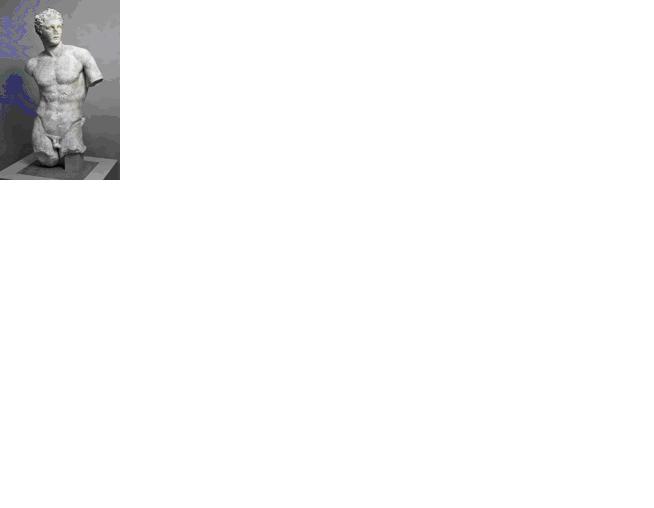
Image |
|
Name @ Provenance: Meleager
(probably by Skopas)
Findspot @ Date: 340BC.
Present Location:
Arthur M.
Sackler Museum,
Harvard University
Description: Made
close to the end of the Classical era, an image of a generic powerful hero.
Characteristic traits of new facial style: squarish skull, squarish forehead in
two planes, deep set eyes, bulging brows, open mouth, and an expression of
intensity and strain.
Interpretation:
Probably by Skopas because of its similarity to the Tegea heads. |
| |
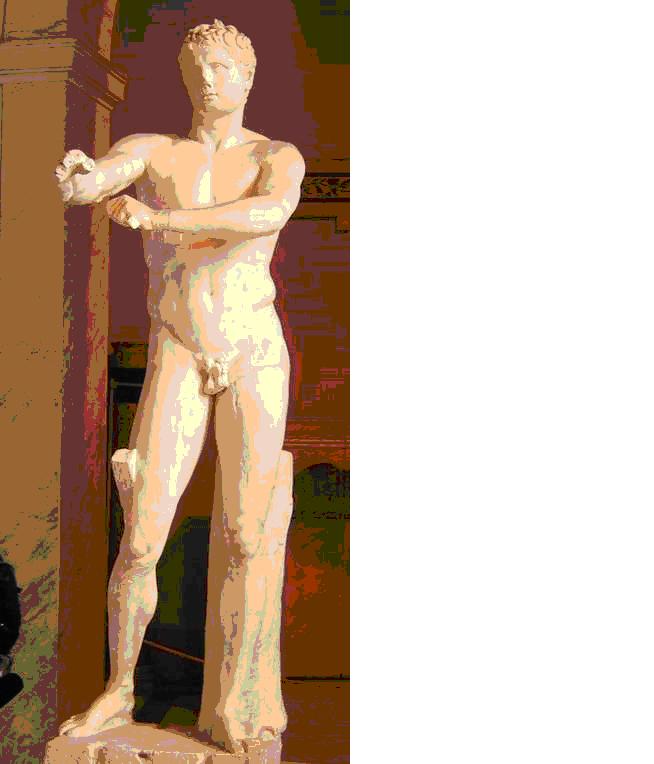
Image |
|
Name @ Provenance: Apoxyomenos
(man scraping himself) by Lysippos
Findspot @ Date: Roman
copy of Greek original, 350-325BC.
Material @ Size: Bronze,
6ft. 8.5in.
Present Location:
Vatican Museums,
Rome
Description: Athlete
using a strigil to scrape the oil off his body. One arm stretched out directly
in front while the other scrapes. Broad front of torso has been broken.
Outturned foot, bent knee, and shifting horizontal axis.
Interpretation:
Directly challenges the Classical four-sided approach – viewer is forced to
contemplate views other than frontal and profile. 3D movement, perfection of
the contraposta at last. |
| |
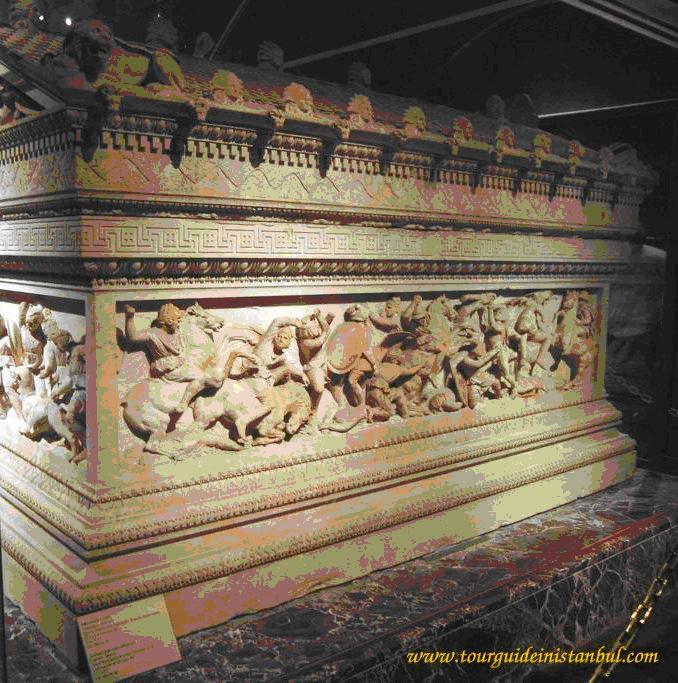
Image |
|
Name @ Provenance: Alexander
Sarcophagus (morellikely the sarcophagus of Abdalonymos)
Findspot @ Date: Sidon, 320BC.
Material @ Size: Marble,
10 and 3/5in frieze
Present Location:
Archaeological museum, Istanbul
Description: Coffin
shaped like a temple w/ rich architectural moldings. Frieze panels on all four
sides show battle scene. Greeks fight Persians in pediments. Lions on lid which
was separate. Short sides showed hunting scene and battle scene. On one long
side Greeks and Persians hunting together on the other, them in battle against
each other. Figures painted. Composition dense and crowded.
Interpretation: Carries
the only original contemporary representation of Alexander himself. |
| |
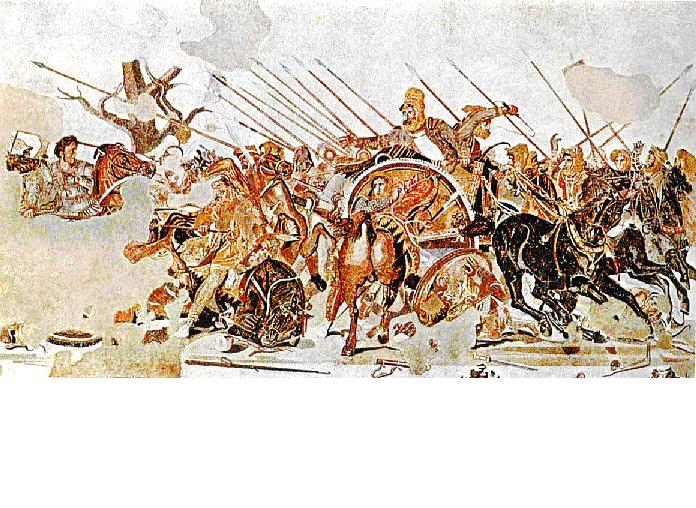
Image |
|
Name @ Provenance: Alexander
Mosaic (original by Philoxenos of Eretria)
Findspot @ Date: Floor
mosaic from Pompeii,
adaptation of a Greek wall painting c. 310
Present Location:
National Museum,
Naples
Description: Depict
turning point in the Battle of Issos between Greeks and Persians and the
confrontation between Alexander and Darius.
Interpretation:
Similar to Philoxenos’ wall painting |
| |
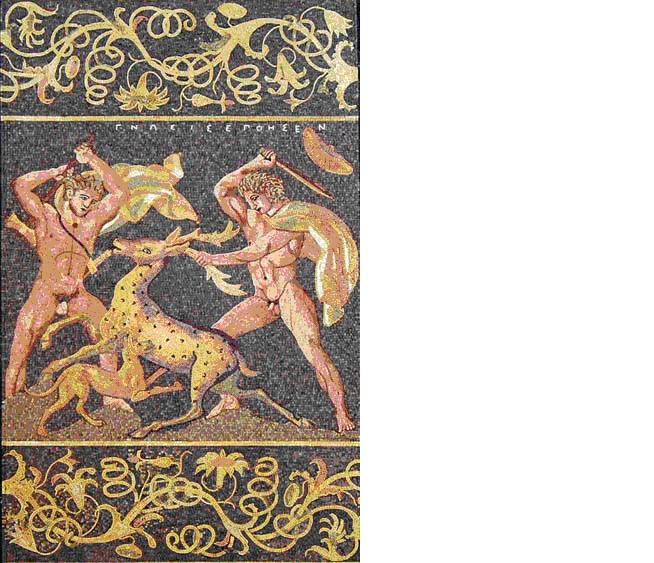
Image |
|
Name @ Provenance: Stag
hunt, signed by Gnosis
Findspot @ Date: Pella (Macedon), c. 300BC.
Material @ Size: Pebble
mosaic, 10ft. 2in
Description: Outer
border, wave pattern; inner is floral design; small inner panel shows stag
hunt. Light figures against a dark background. Pebbles closely packed and
uniform in size
Interpretation:
Source of the mosaics’ designs, techniques, and themes is up for debate.
|
| |
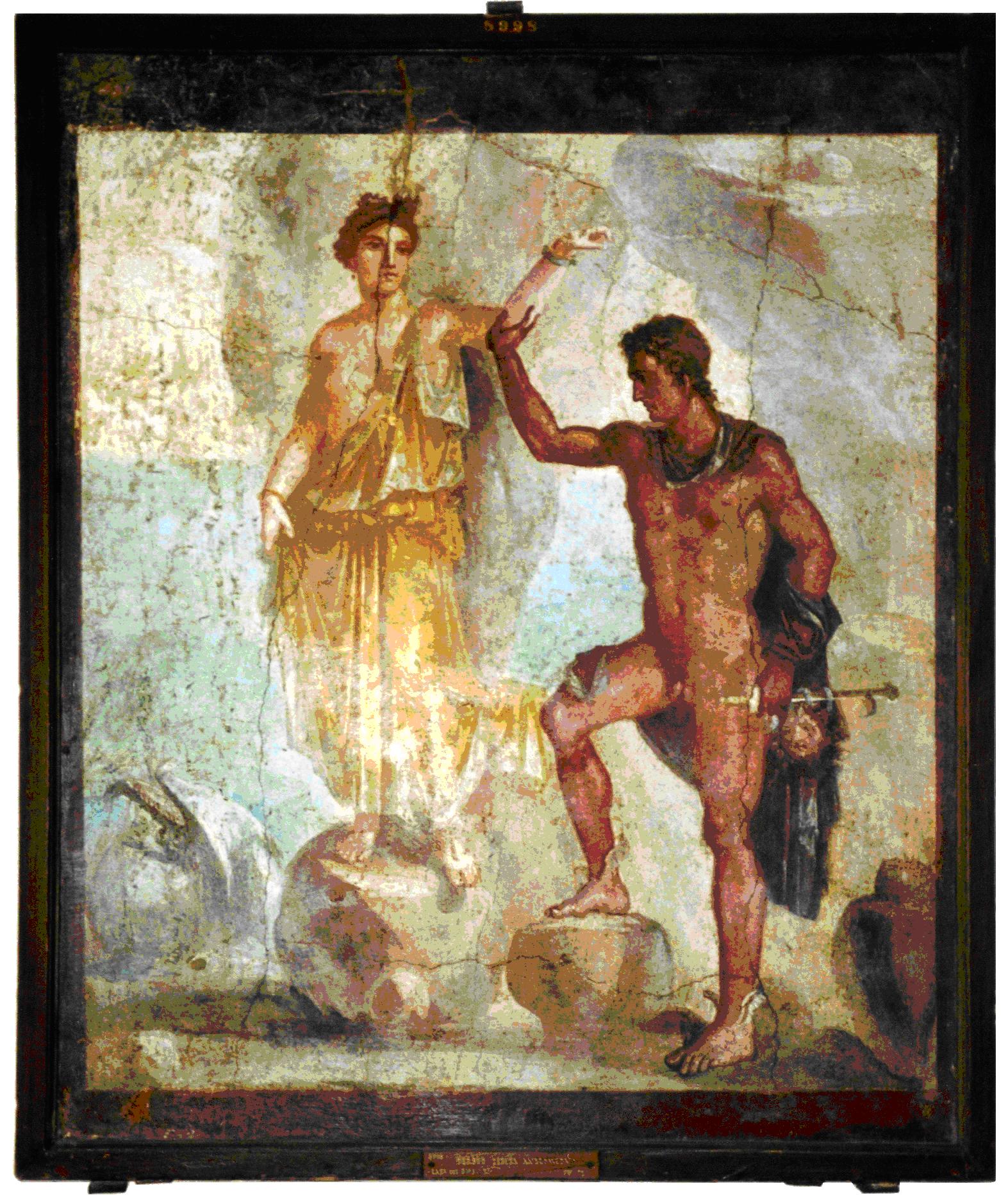
Image |
|
Name @ Provenance: Perseus
freeing Andromeda
Findspot @ Date: House
of Dioscourides at Pompeii,
Greek original 4th century BC maybe by Nikias
Material @ Size:
Wall painting
Present Location:
National Museum,
Naples
Interpretation: Mythological
themes common for wall painting, probably copied from an original by Nikias.
Small variation in two paintings suggests a common Greek original. |
| |
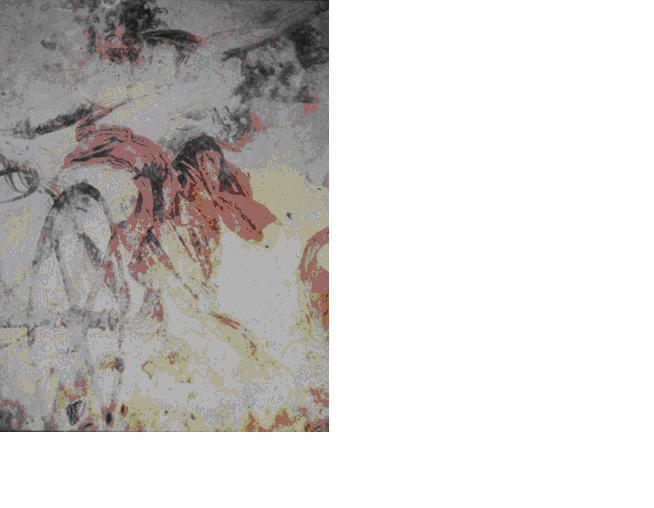
Image |
|
Name @ Provenance: hades
carrying off Persephone.
Findspot @ Date: Tomb
of Persephone, Vergina; c. 340BC.
Material @ Size: Wall
painting, frieze is 3ft. 4in.
Description: Persephone
flings herself sideways to escape arms outstretched towards a kneeling
terrified companion who is being left behind. Use of perspective creates
illusion of depth (ex. Wheel). Shading lends volume to faces and drapering.
Color, fine composition, sense of movement, deft drawing especially of facial
features create drama. |
| |
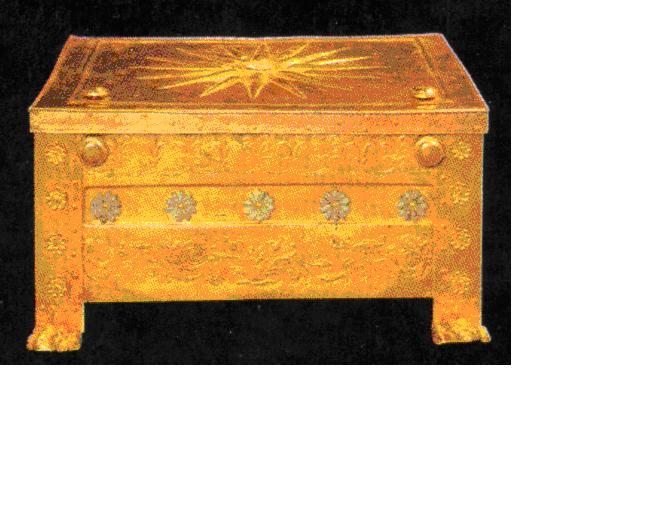
Image |
|
Name @ Provenance: Larnax,
containing bones of the dead
Findspot @ Date: Tomb
of Philip, Vergina c. 340 -310BC.
Material @ Size: Gold,
16x13x8
Present Location:
Archaeological Museum, Thessaloniki
Description: Gold
star on top, burnt bones of deceased wrapped in purple and purple cloth.
Decorated with lotus and palmette and and rosette registers with lions paws.
Interpretation: Homer’s
description of the shroud and bones of Hector in the Iliad. Offerings for the
dead found with it. |
| |
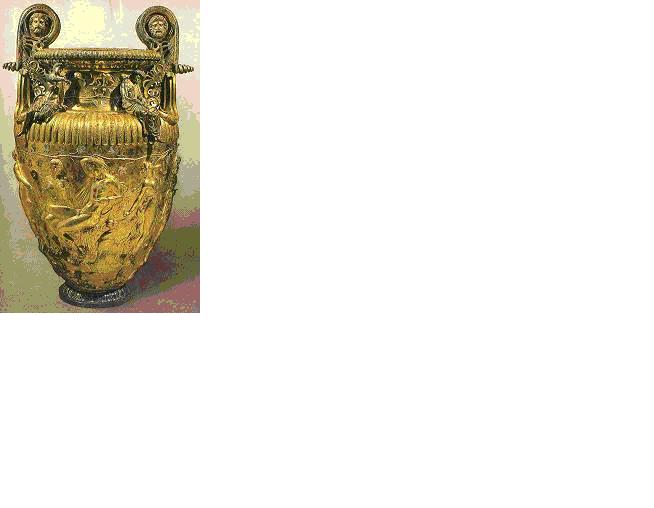
Image |
|
Name @ Provenance: Krater,
from Derveni
Findspot @ Date: c.
330BC.
Material @ Size: Gilded
bronze, copper, and silver, 3ft
Present Location:
Archaeological Museum, Thessaloniki
Description: Dionysus
and Ariadne is wholly 4th century Greek
Interpretation: Extravagant
decoration speaks to the wealth and status of the patrons.
|
| |
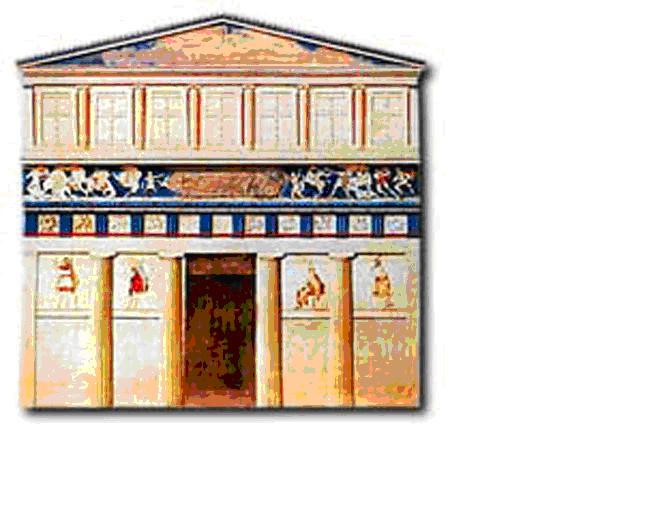
Image |
|
Name @ Provenance: Façade
of the tomb at Lefkadia
Findspot @ Date: c.
300BC.
Material @ Size:
Stucco, limestone ashlars, 27ft.
Description: Simple
tomb with a pair of barrel vaulted chambers. Architecture mixes Doric and Ionic
orders allude to earlier building styles. Highly ornate, almost baroque
Interpretation: Important
for architectural aspects and its paintings. Powerful Greek imagery derived
from religious architecture (Parthenon) thus continued to be expressed in this
new Macedonian façade architecture. |
| |
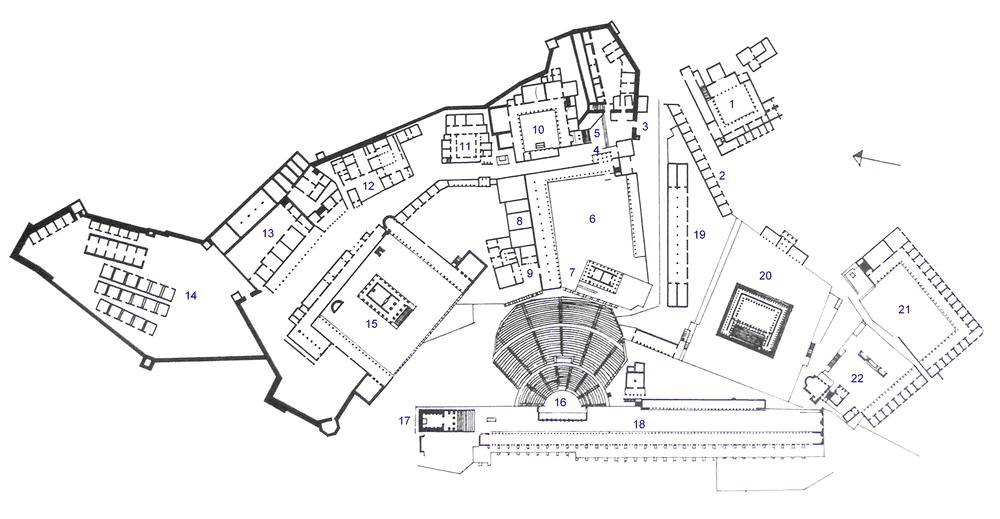
Image |
|
Name @ Provenance: Plan
of the upper city, Pergamon
Findspot @ Date: 3rd
– 2nd centuries
Description: Theater
is prominent, underscoring the threatricality of the setting – panoramas of
mountains out one side. |
| |
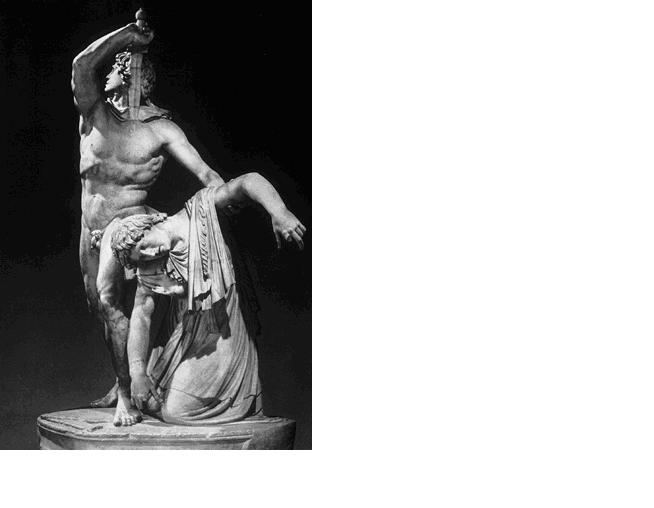
Image |
|
Name @ Provenance: Gaul and his wife
Findspot @ Date: Roman
copy of a c. 220BC. Hellenistic group
Material @ Size: Bronze
original, 6ft. 11in
Present Location:
Therme Museum,
Rome
Description: Defeated
Gaul kills his wife then dramatically stabs
himself. Completely carved in the round, contrasts vigorous male body with
female collapsing in death. Baroque -
twisting posture, exaggerated musculature, high drama.
Interpretation:
Associated with the dedications made by King Attalos at Pergamon to celebrate
victory over the Gauls. Gauls prefer suicide to surrender and becoming a slave.
Makes him a noble hero. |
| |
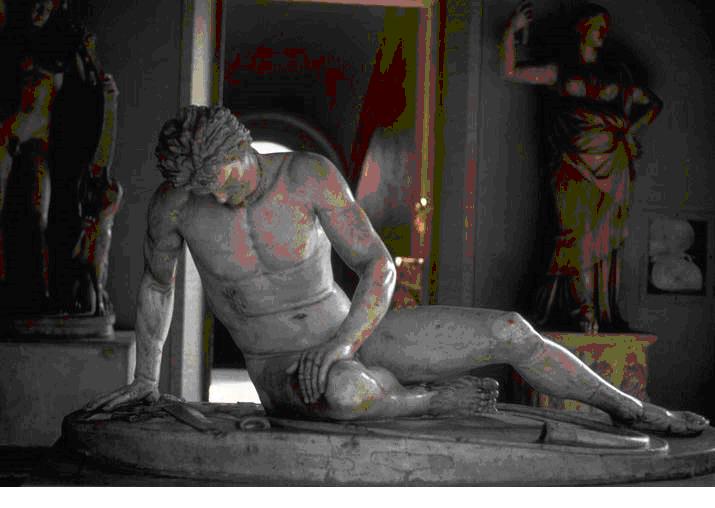
Image |
|
Name @ Provenance: The
Dying Gaul (trumpeter)
Findspot @ Date: 220BC.
is Hellenistic original
Material @ Size: Marble,
36.5in.
Present Location:
Capitoline Museum,
Rome
Description: Figure
should be viewed from several points, hair brushed back, untidy mustache,
horn-shaped trumpet. Vivid stab wound.
Interpretation: One
of the group of Gauls.
|
| |
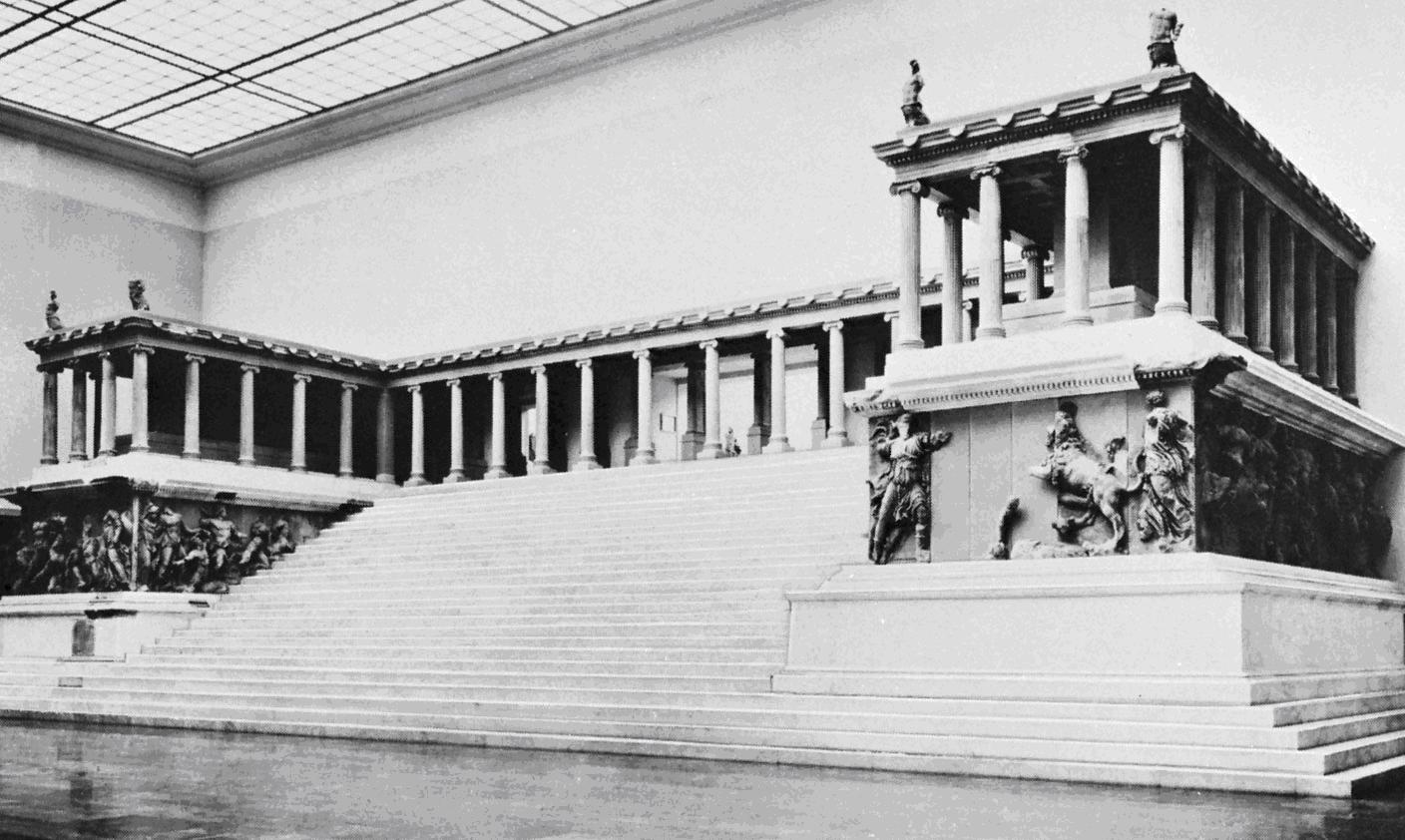
Image |
|
Name @ Provenance: The
Great Altar: west side as reconstructed in Berlin
Findspot @ Date: Pergamon,
175-150BC.
Material @ Size: Marble,
102ft. wide
Present Location:
Staatliche Museen, Berlin
Description: Built
during regin of Eumenes II
Interpretation:
Altar was probably built to mark the successful crushing of the revolt of the
Gauls in 167BC, dedicated in honor to all the gods. |
| |

Image |
|
Name @ Provenance: The
Great Altar: north wing
Findspot @ Date: Pergamon,
175-150BC.
Material @ Size: Marble,
7ft. 7in frieze
Present Location:
Staatliche Museen, Berlin
Description: The
altar stood on a platform with wings projecting forward at north and south on
either side of a broad suitcase. The platform supported an Ionic colonnade,
podium below decorated with a frieze. 200 figures, almost all the gods.
|
| |
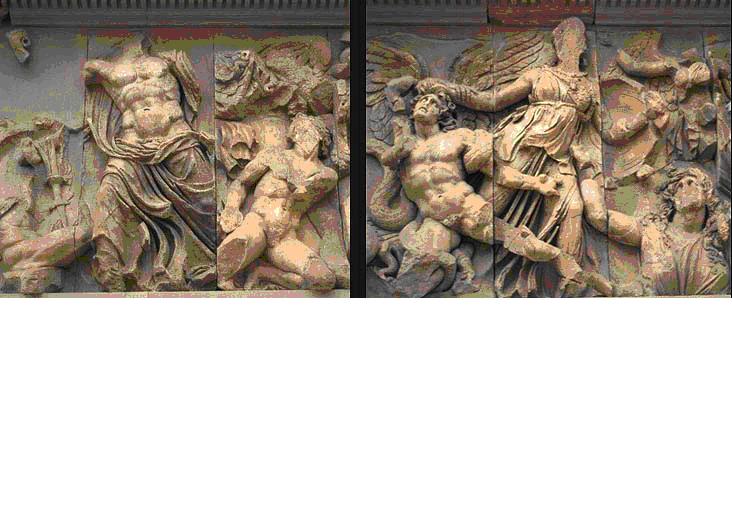
Image |
|
Name @ Provenance: The
Great Altar: east frieze (detail): Zeus fighting giants
Findspot @ Date: Pergamon,
175-150BC.
Material @ Size: Marble,
7ft. 7in.
Present Location:
Staatliche Museen, Berlin
Description: Zeus
fighting giants by flinging lightning bolts at them
Interpretation: Moments
of physical and emotional intensity are emphasized by tense bodies, violent
postures, exaggerated muscles and torsos, legs, and arms, open mouths, and deep
set eyes, furrowed brows, and shocks of unruly hair. Swirling drapery enhances
the dramatic effect. |
| |
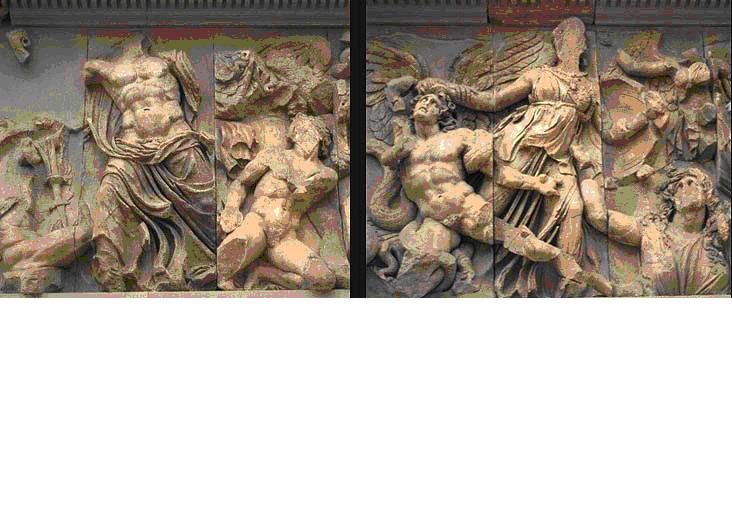
Image |
|
Name @ Provenance: The Great Altar:
east frieze (detail): Athena fighting giants
Findspot @ Date: Pergamon,
175-150BC.
Material @ Size: Marble,
7ft 7in.
Present Location:
Staatliche Museen, Berlin
Description: Athena
fighting giants
Interpretation:
Moments of physical and emotional intensity are emphasized by tense bodies,
violent postures, exaggerated muscles and torsos, legs, and arms, open mouths,
and deep set eyes, furrowed brows, and shocks of unruly hair. Swirling drapery
enhances the dramatic effect. |
| |
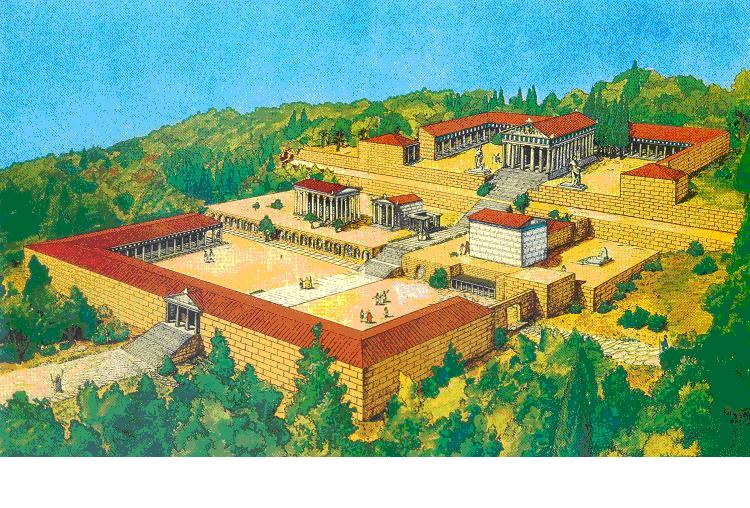
Image |
|
Name @ Provenance: Sanctuary
of Asklepios, Kos; restoration of fully
developed plan
Description: Coordinated
terraces with ramps and stairs. The Doric Temple of Asklepios stood on the top
terrace flanked on three sides by a stoa, approached by climbing a flight of
stairs. Temple
surrounded by sacred grove of trees. Elaborately contrived climbing
architecture led worshipers to the culminating terrace where they were to sleep
and be cured.
Interpretation: Asklepios,
god of health, received devotees at this center of worship
|
| |
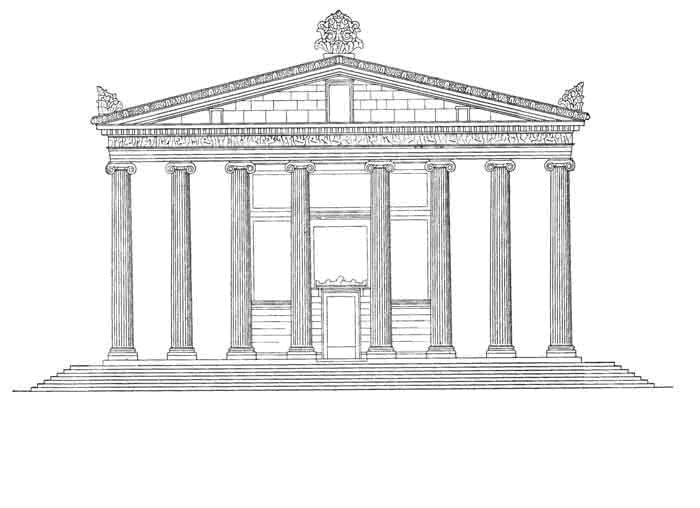
Image |
|
Name @ Provenance: Elevation
of the Temple of Artemis
Findspot @ Date: Magnesia,
175BC.
Description: Ionic
order, by Hermogenes. Podium of seven steps, wide areas between columns and
slender columns.
Interpretation: Shows
precision only derived from drawing on a drafting board first.
|
| |
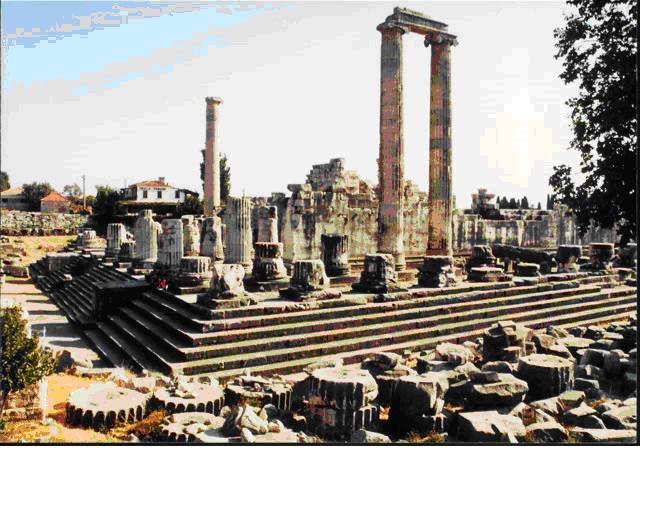
Image |
|
Name @ Provenance: Temple of Apollo: from the east
Findspot @ Date: Didyma,
330BC. and later
Material @ Size: Columns
64ft. 6in. and 120x56yrds.
Description: Front
steps of podium raised it up high, deep pronaos, carved column bases, false
entrance.
Interpretation: Central
doorway 6ft. higher than the porch, probably the place where oracular responses
were pronounced. |
| |
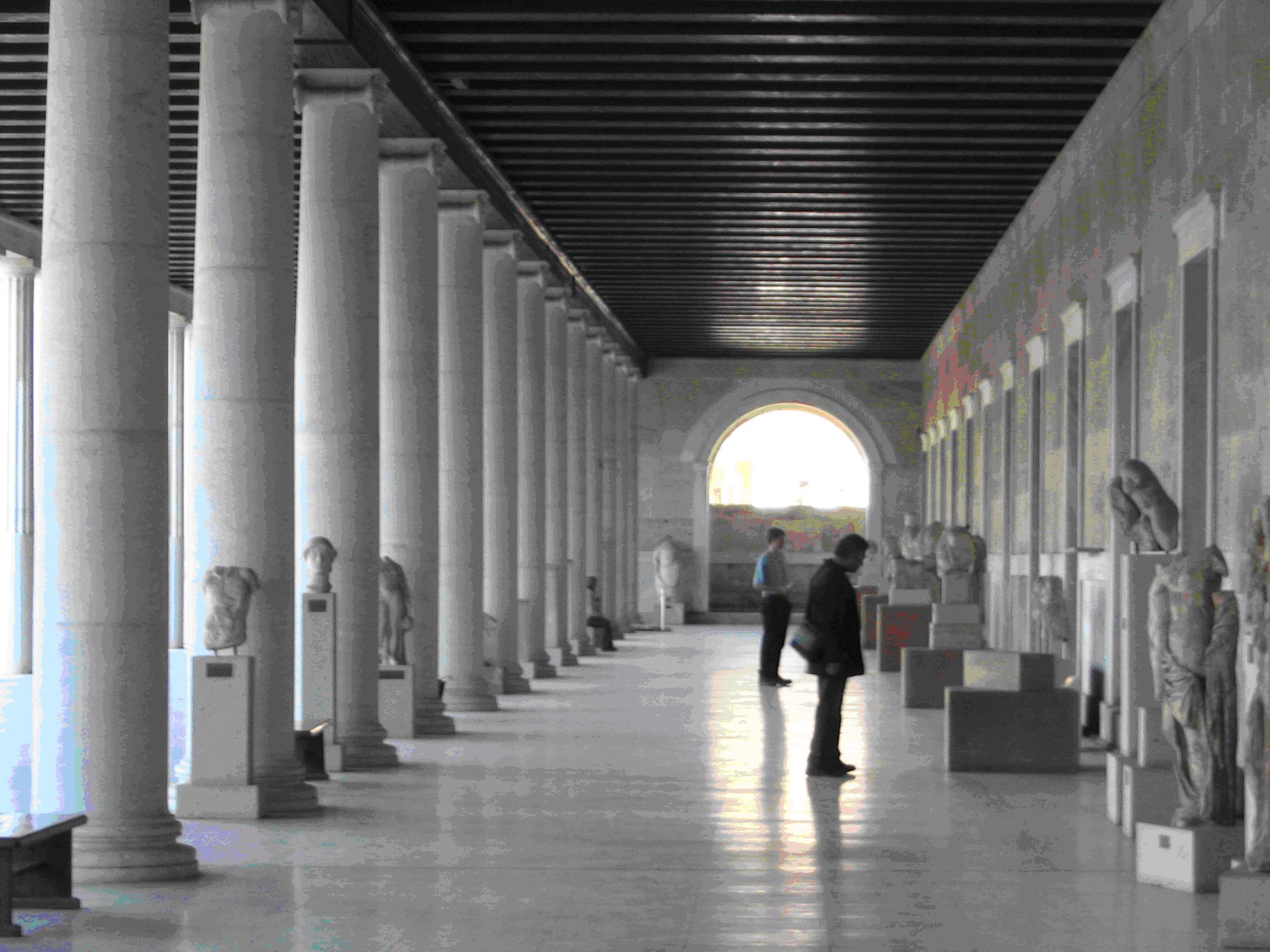
Image |
|
Name @ Provenance: Agora,
Athens, Stoa of
Attalos
Findspot @ Date: 150BC.
Material @ Size: Marble
for façade and columns, and limestone
Preservation: Reconstruced
through the generosity of John D. Rockefeller in 1956
Description: Ground
floor interior from the south showing use of Doric order on the exterior, ionic
on the interior
Interpretation: A
gift from the king of Pergamon and his wife. Purpose built for shopping.
|
| |
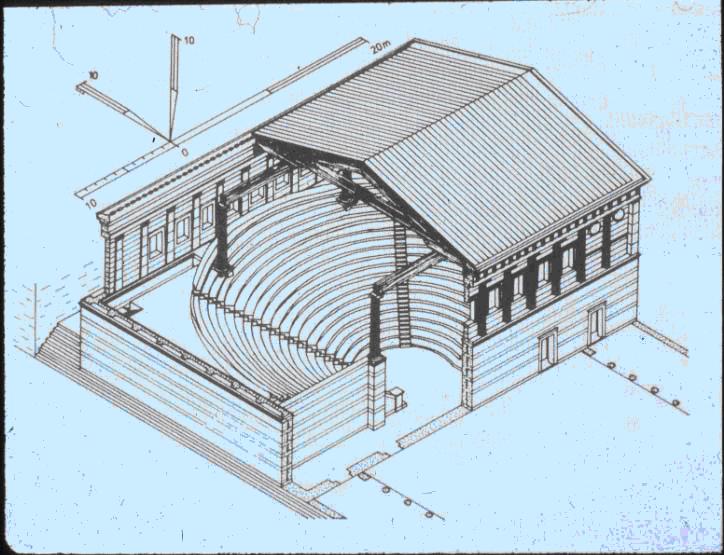
Image |
|
Name @ Provenance: Isometric
drawing, cut away, of the Bouleuterion
Findspot @ Date: Miletus, c. 170BC.
Description: The
chamber arranged like a theater with rows of seats in concentric semicircles.
Interpretation: Principal
speakers could address the council from the floor; interesting that as Athenian
government weakened, architecture got stronger. |
| |
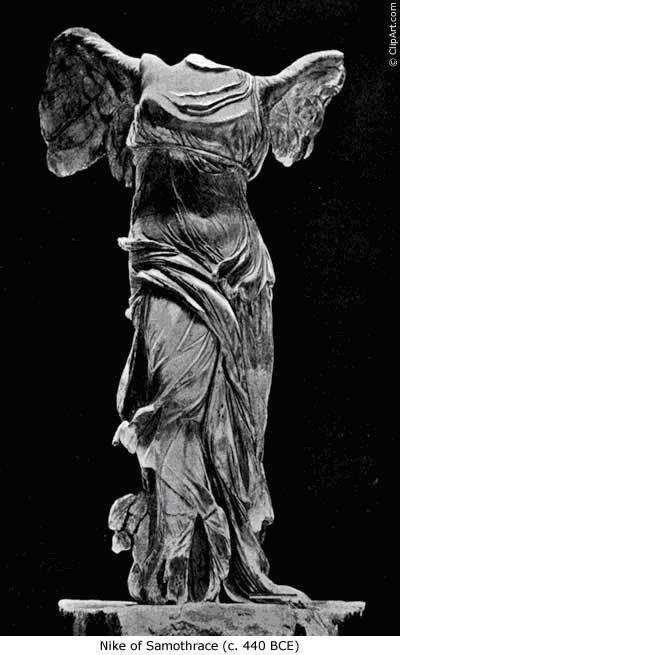
Image |
|
Name @ Provenance: Nike
(victory) of Samothrace alighting on the
victorious ship, perhaps by Pythokritos of Rhodes
Findspot @ Date: c.
180BC.
Material @ Size: Marble,
8ft. 1in.
Present Location:
Musee du Louvre, Paris
Description: Classical
resonance and baroque vitality. Landing from flight, wings outspread. She stood
on a base the shape of a ships prow. Sanctuary at the top of a cliff. Spiraling
drapery; brilliant but brittle.
Interpretation: Nike
guides the vessel (ship of State?) through perilous seas - metaphor |
| |
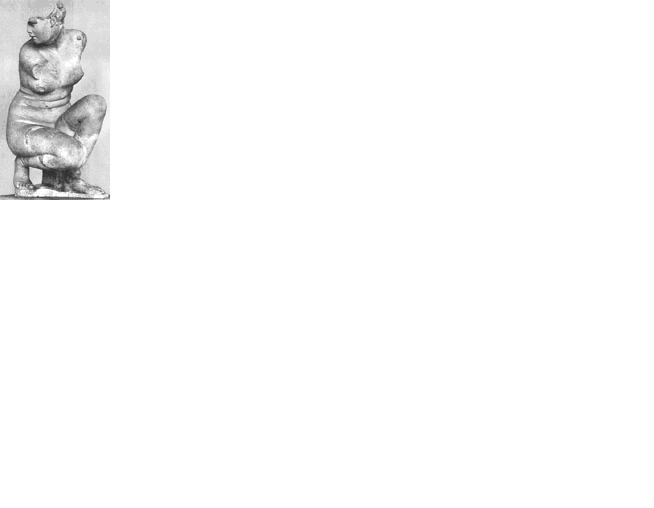
Image |
|
Name @ Provenance: Crouching
Aphrodite
Findspot @ Date: Original
200-150BC.
Material @ Size: Marble,
2ft 8.25in.
Present Location:
Terme Museum,
Rome
Description: Altogether
new sculptural pose. Nude goddess at bath emphasizes appeal of the flesh
Interpretation: Dependent
on the Classical figural type |
| |
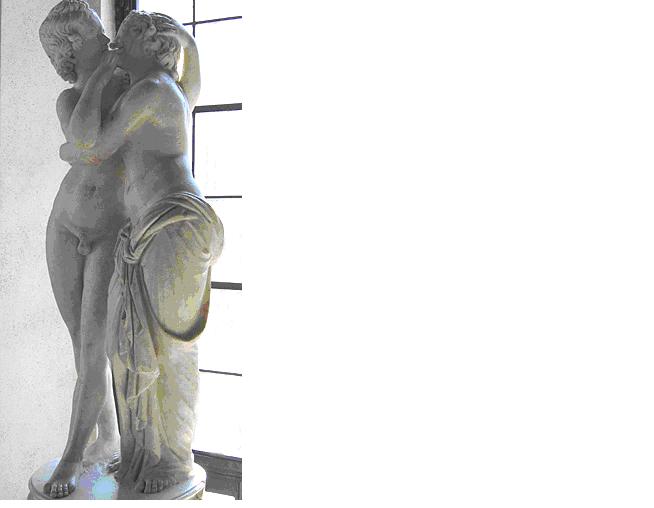
Image |
|
Name @ Provenance: Eros
and Psyche
Findspot @ Date: Original
version: 150-100BC.
Material @ Size: Marble,
4ft 1in.
Present Location:
Capitoline Museum,
Rome
Description: Eros
appears more powerful and sexually charged. Awkward postures underscore
physical and sexual strain.
Interpretation: Children
shown in adult positions. |
| |
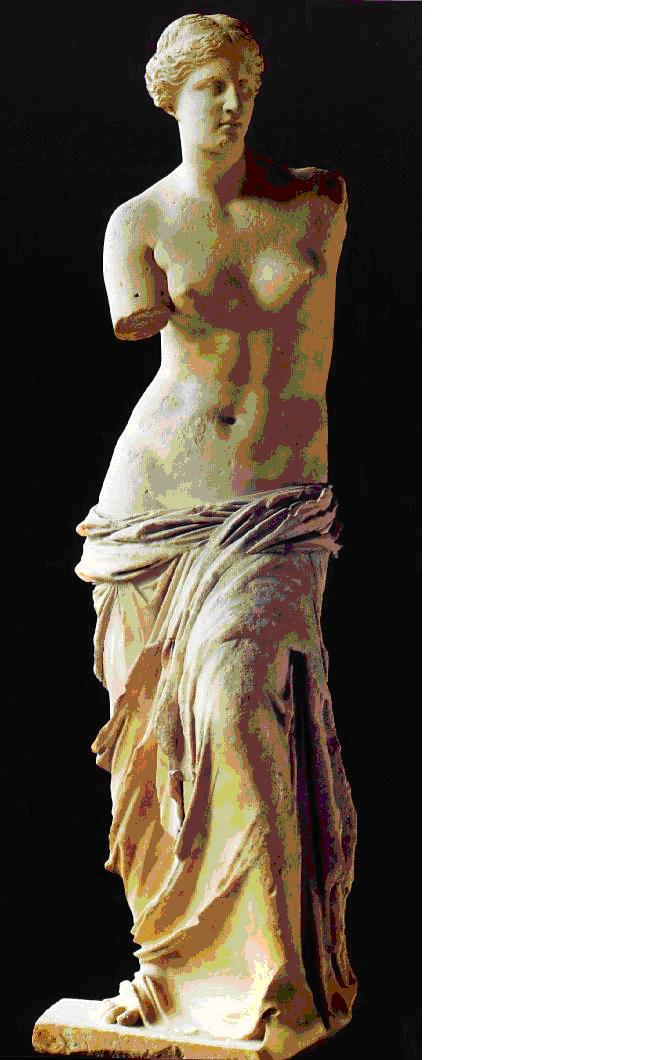
Image |
|
Name @ Provenance: Aphrodite of Melos (Venus de Milo)
Findspot @ Date: Island of Melos, 125-75BC.
Material @ Size: Marble,
6ft. 8.25in.
Present Location:
Musee du Louvre, Paris
Description: Over
lifesize, left leg sharply forward. Praxitelean s-curve. Face is Late Classical
Interpretation: Influence
of Classical sculpture especially the Aphrodite of Knidos |
| |
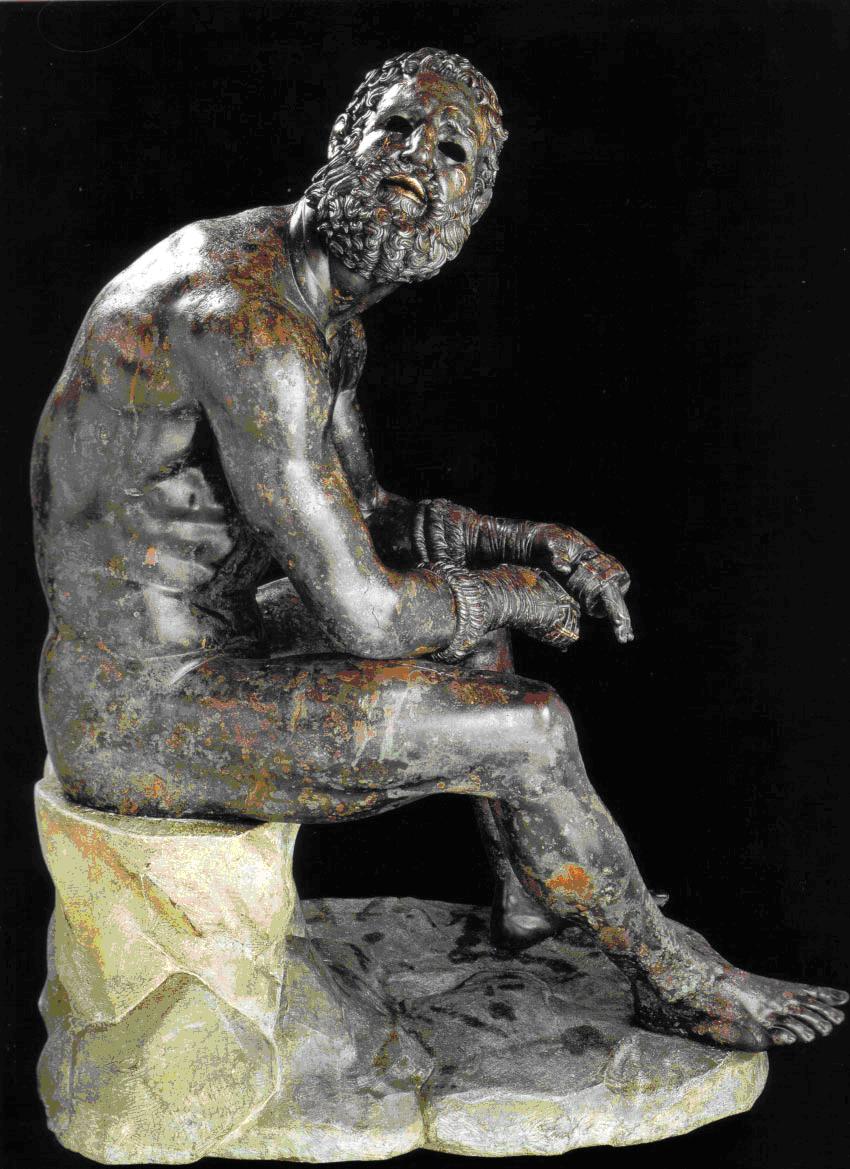
Image |
|
Name @ Provenance: Seated
boxer, found with the bronze Hellenistic ruler
Findspot @ Date: Found
in a Roman house on the Esquiline,100-50BC.
Material @ Size: Bronze
with copper for lips and patches of blood, 4ft. 2in.
Present Location:
Terme Museum,
Rome
Description: Broken
nose, swollen ears, swelling muscles
Interpretation: Purposely
contrasts the Hellenistic fighter with the heroic “ideality” of Classical
athletes |
| |
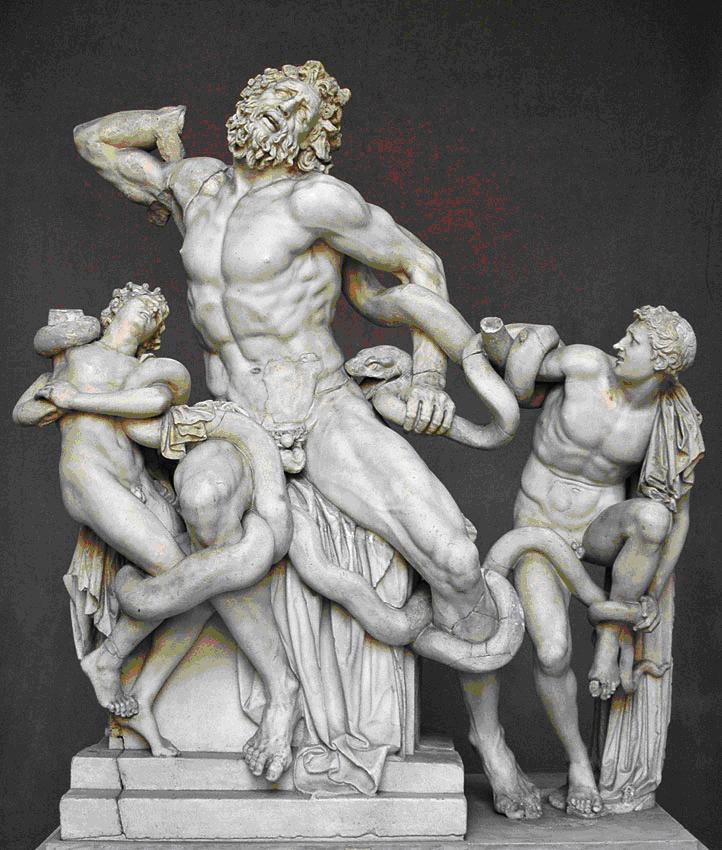
Image |
|
Name @ Provenance: The
Laocoon group attributed to Rhodian sculptors
Findspot @ Date: 2nd
century BC or 1st century AD
Material @ Size: Marble,
6ft .5in.
Present Location:
Vatican Museums,
Rome
Description: Twisting
contorted figures, exaggerated anatomy of Laocoon, anguished fearful
expressions and high drama of the struggle place it close to the Pergamon altar
frieze.
Interpretation: Continued
commitment to baroque trends. Trojan priest Laocoon is about to warn Trojans of
danger inside wooden horse when Poseidon sends sea serpents to take away him
and his sons. Subject not in question, but authorship is. |
| |
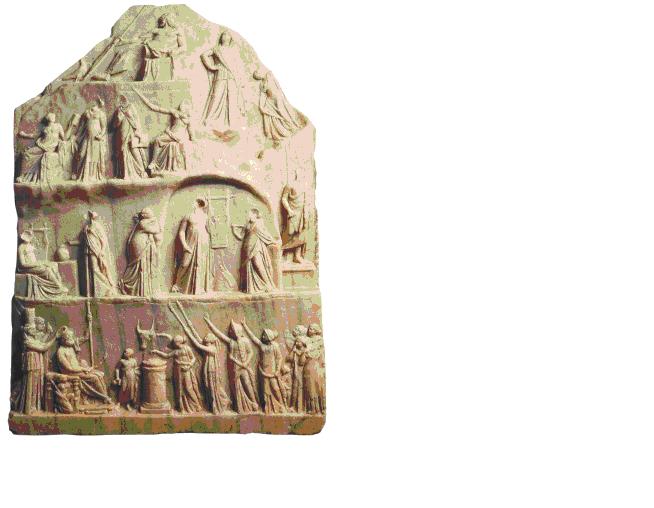
Image |
|
Name @ Provenance: Apotheosis
of Homer by Archelaos of Priene
Findspot @ Date: 125BC.
Material @ Size: marble,
3ft. 9in.
Preservation:
Present Location:
British Museum,
London
Description: Combines
scholarly references with allegory. Figures: Myth, History, Poetry, Tragedy,
Comedy, Human Nature, and the virtues are identified by inscriptions.
Interpretation: Full
of references and allusions to Homer; speaks to the Hellenistic love of symbol,
learning, sophistication, allegory, allusion, abstraction, the theater, and
poetry.
|
| |
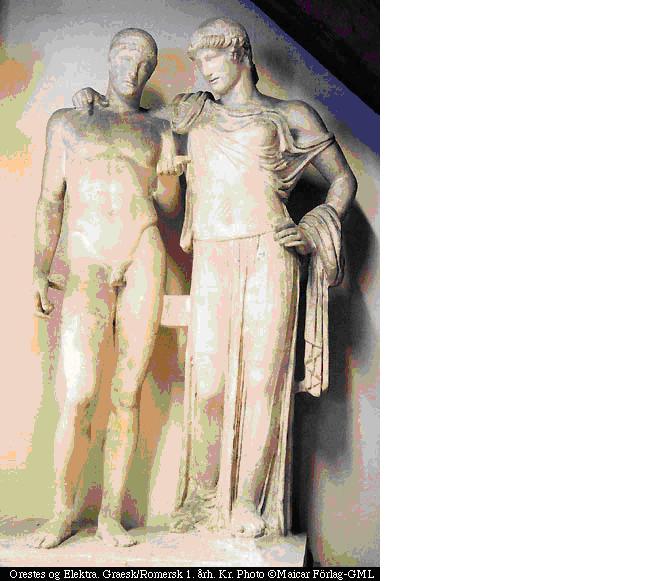
Image |
|
Name @ Provenance: Group
including the Stephanos athlete, perhaps Orestes and Electra
Findspot @ Date: Late
1st century BC.
Material @ Size: Marble,
4ft. 11in.
Present Location:
Archaeological Museum, Naples
Description: Stephanos
athlete joined by a beefy female companion. Seventeen copies of this stephanos
athlete survive.
Interpretation:
Sometimes taken to represent Electra and
Orestes, their identity and meaning varied according to roman context |
| |
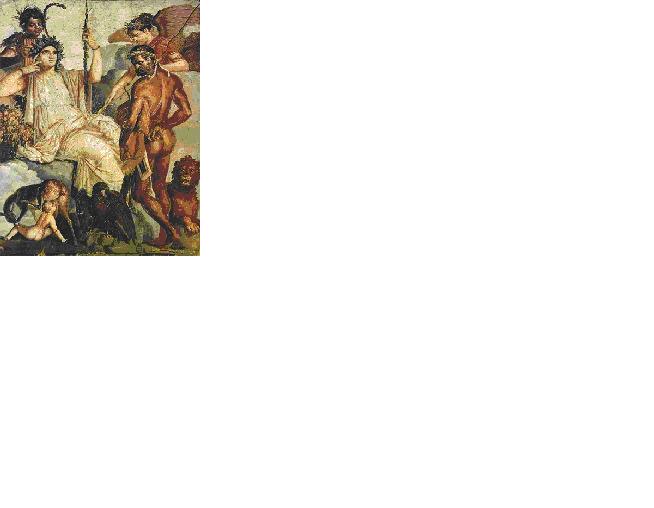
Image |
|
Name @ Provenance: Herakles,
led by Iris, finds his son Telephos
Findspot @ Date: Herculaneum, Roman
version of 2nd century BC. Greek original
Material @ Size: Wall
Painting
Present Location:
National Museum,
Naples
Description: Episode
from the life of Telephos, the legendary founder of Pergamon
Interpretation: Nothing
specifically Roman in the painting, therefore probably a copy of a Hellenistic
original.
|
| |

Image |
|
Name @ Provenance: Nile Mosaic
Findspot @ Date: Sanctuary
of Fortuna, Praeneste; c. 100BC.
Material @ Size: 19ft.
8in x 16ft.
Preservation: Heavily
restored
Present Location:
National Museum, Palestrina
Description: Decorated
the floor of an apsed hall. Shows a Hellenistic adaptation of an old Egyptian
motif. Nile and its humans and animals are
subject of polychrome mosaic.
Interpretation: Prototype
probably created in Alexandria.
Great detail in landscape motifs, variety of boats, buildings, and varied views
of all characteristically Hellenistic.
|
| |
|
